1 RISK MANAGEMENT IN CONSTRUCTION PROJECTS (c) Mikhail
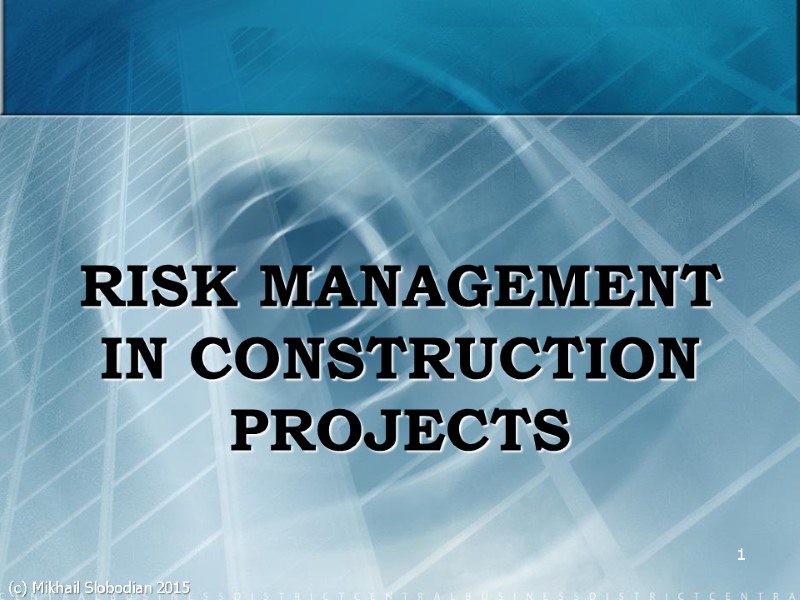
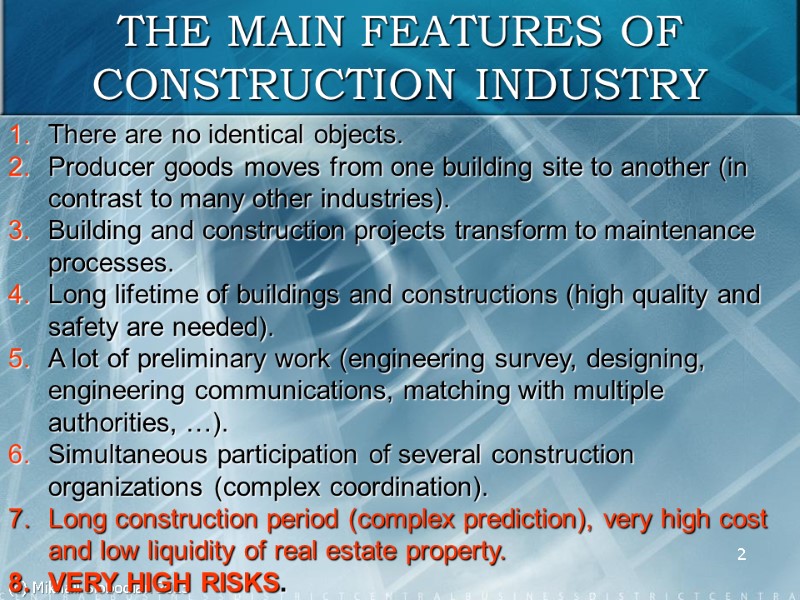
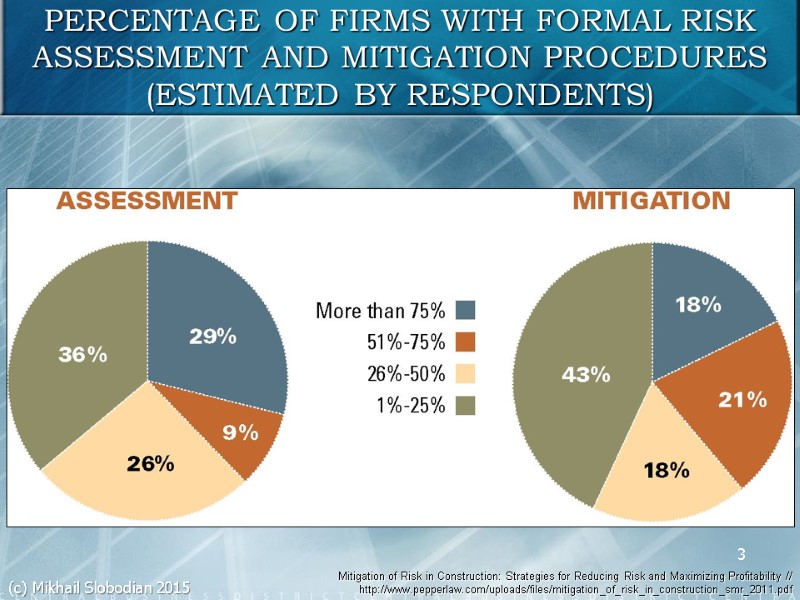
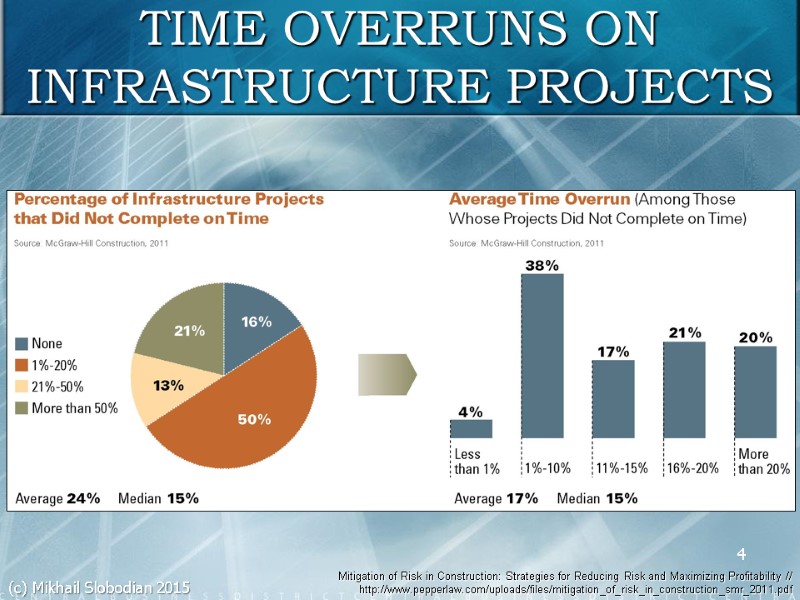
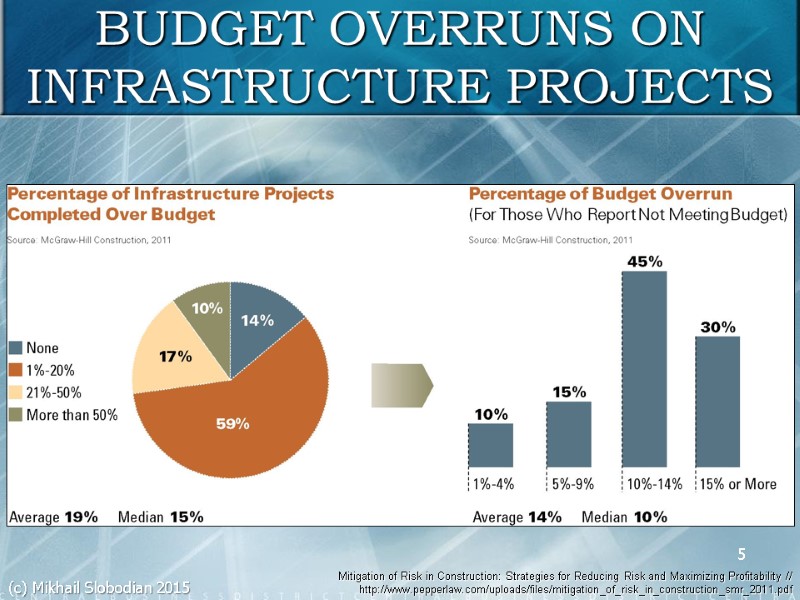
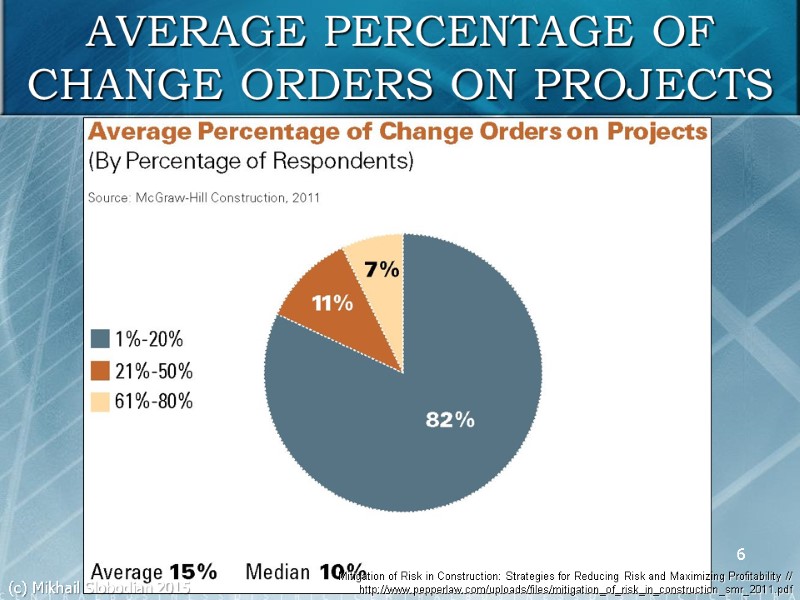
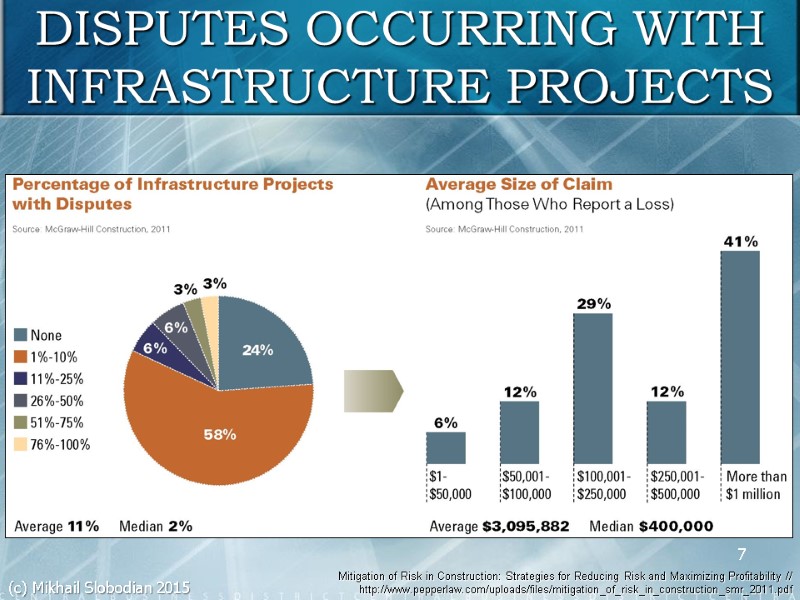
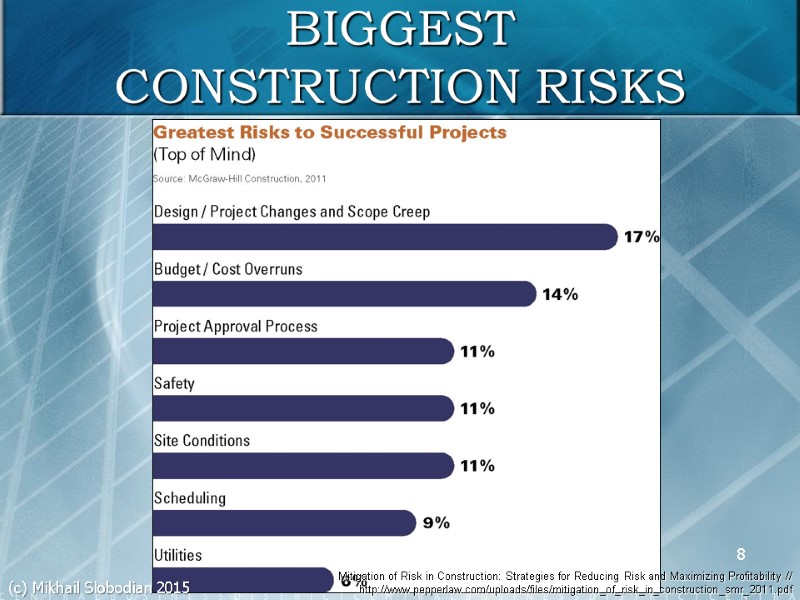
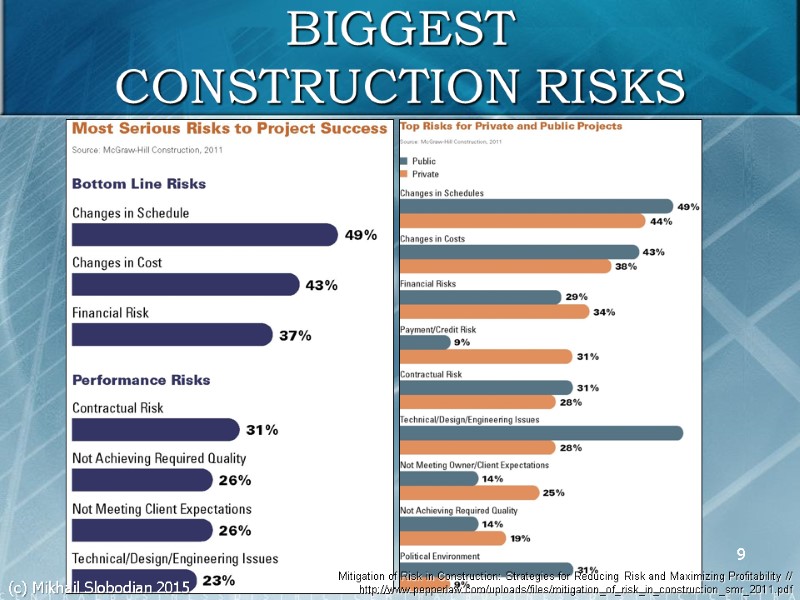
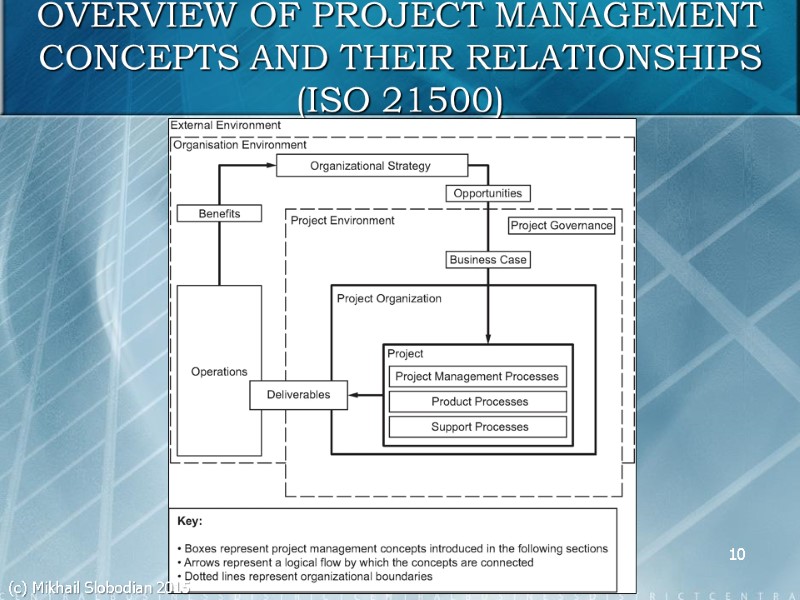
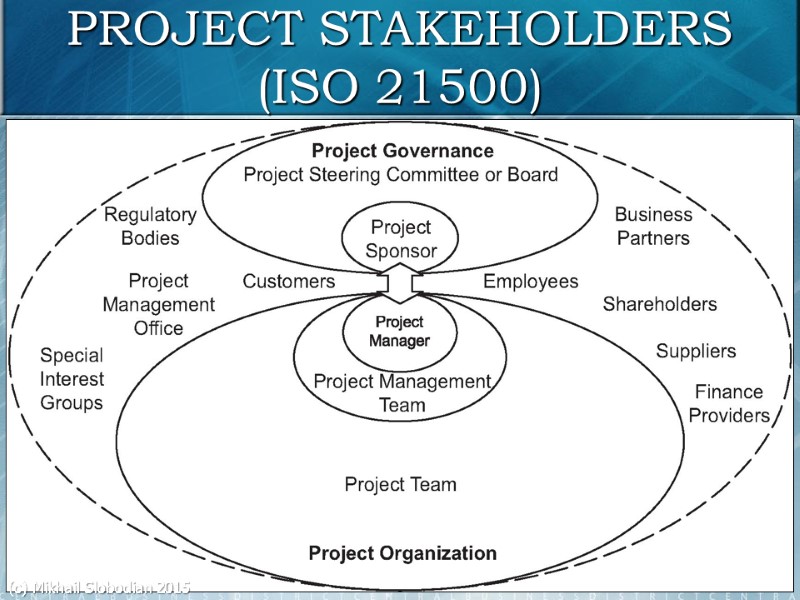

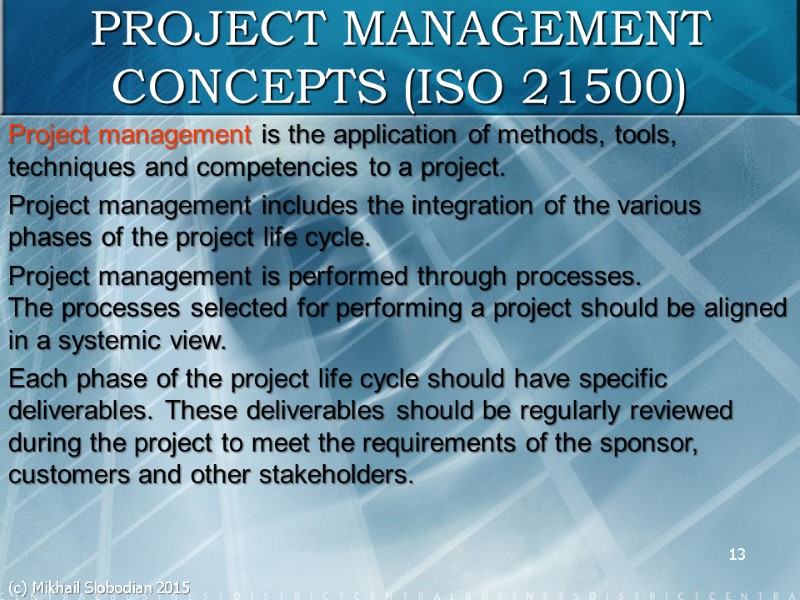
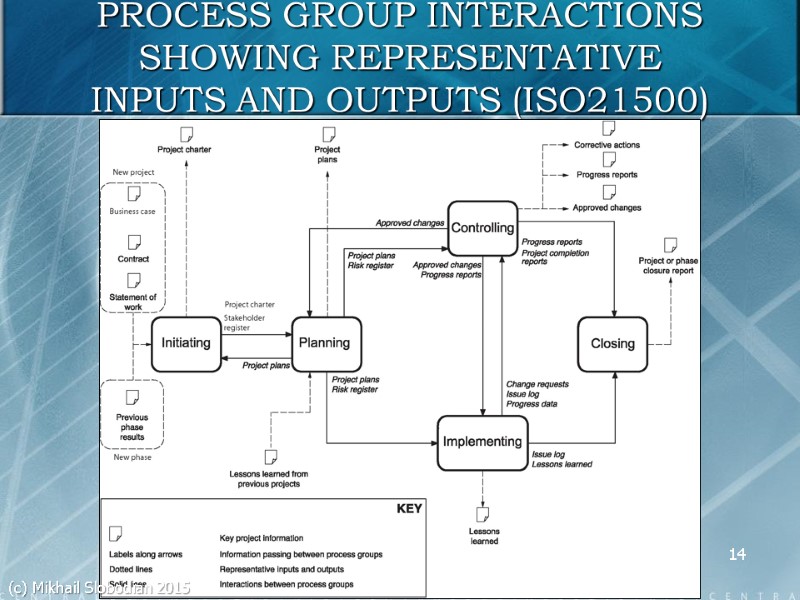
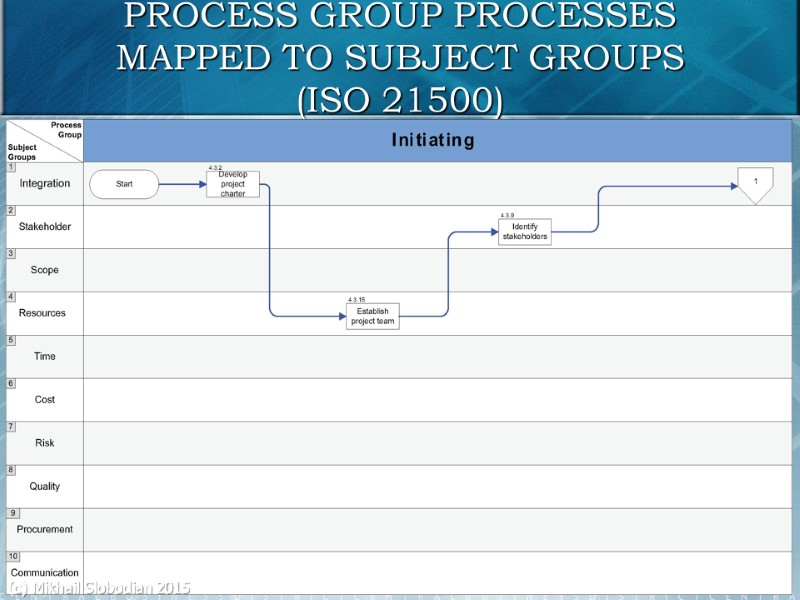
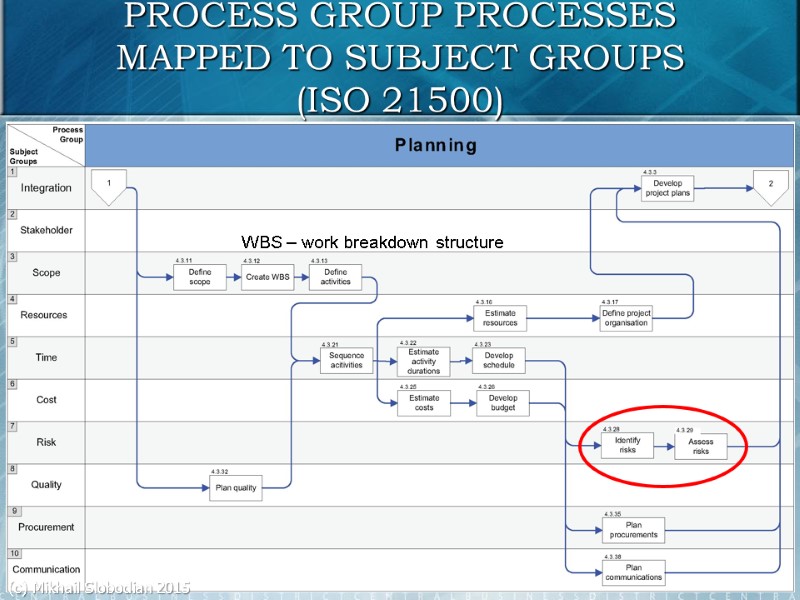
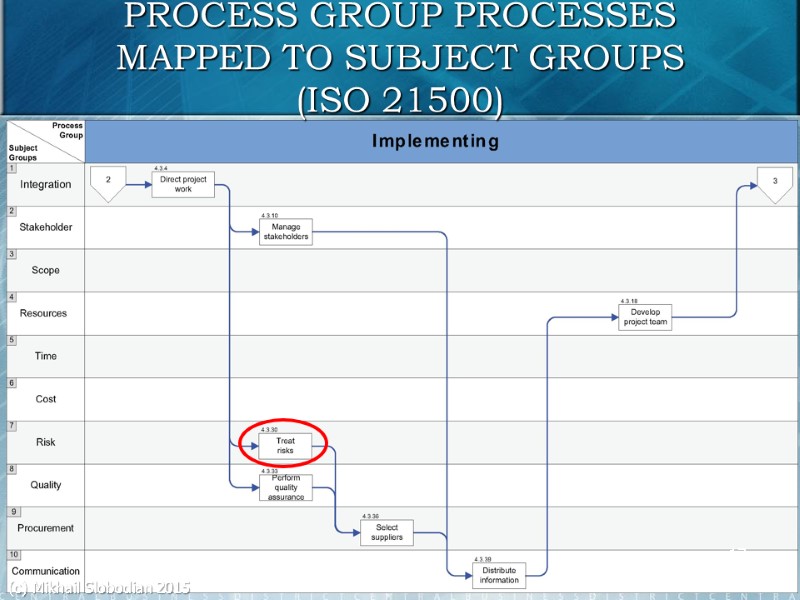
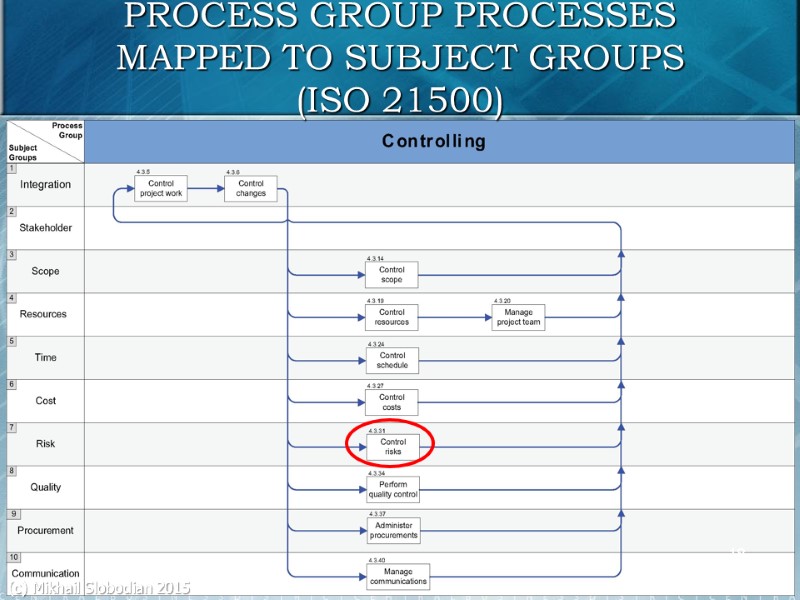
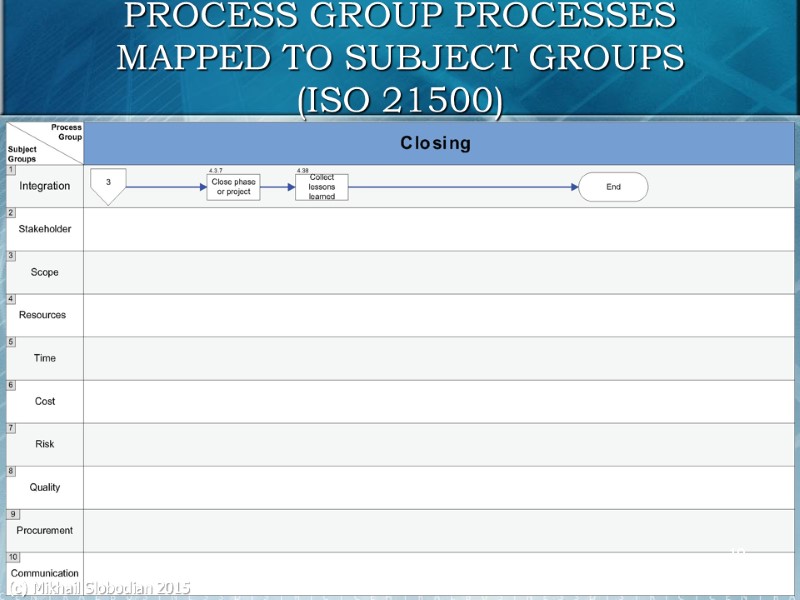
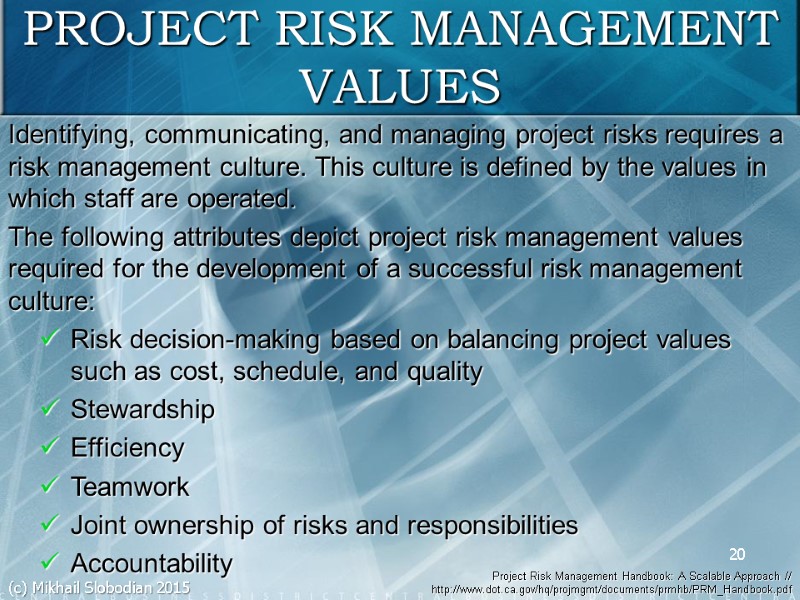
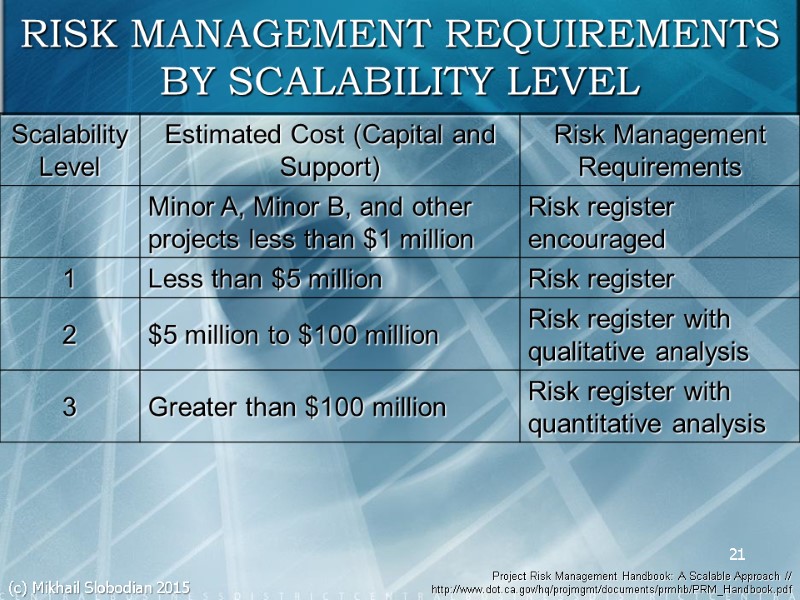
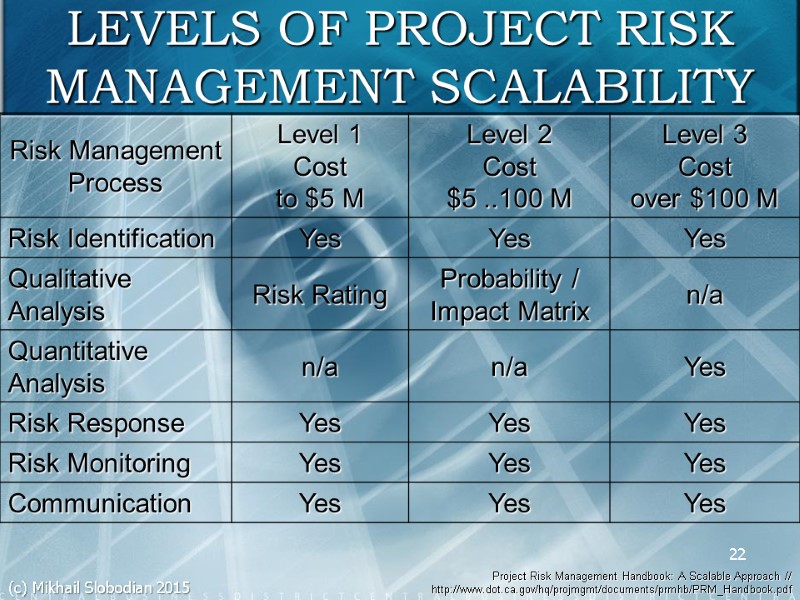
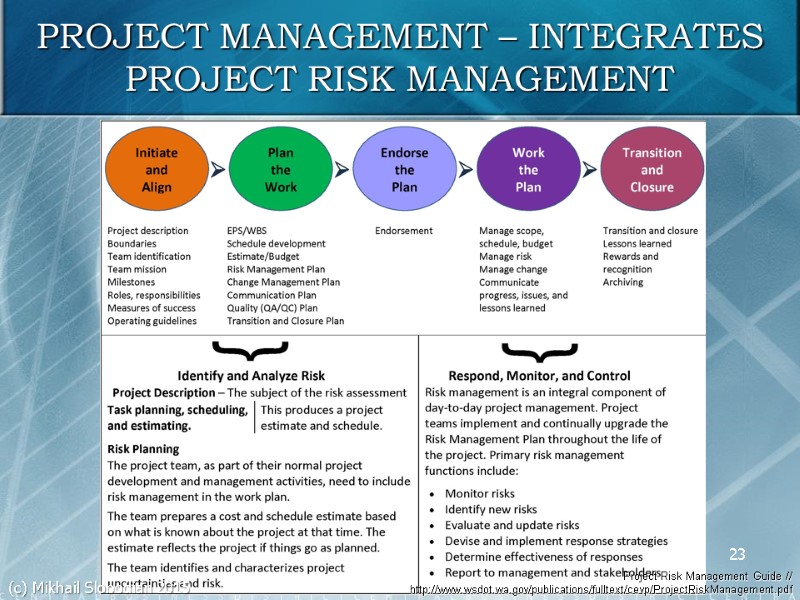
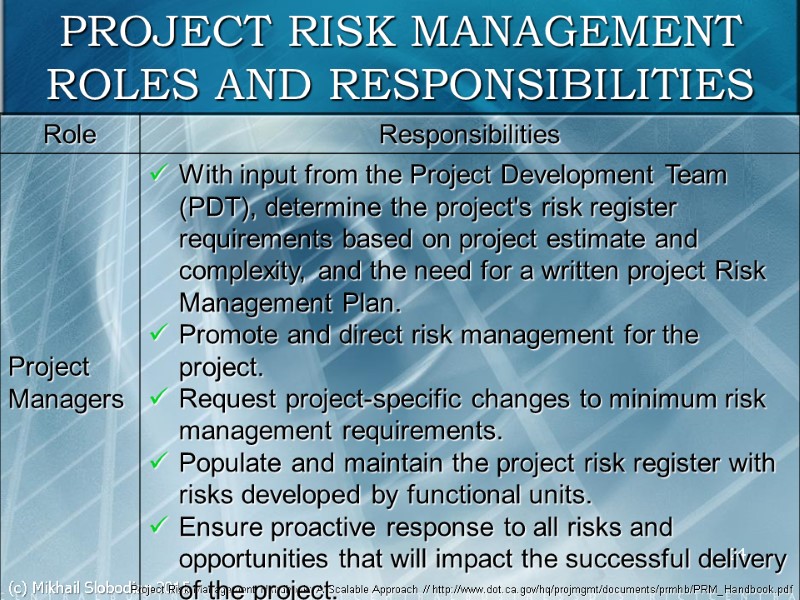
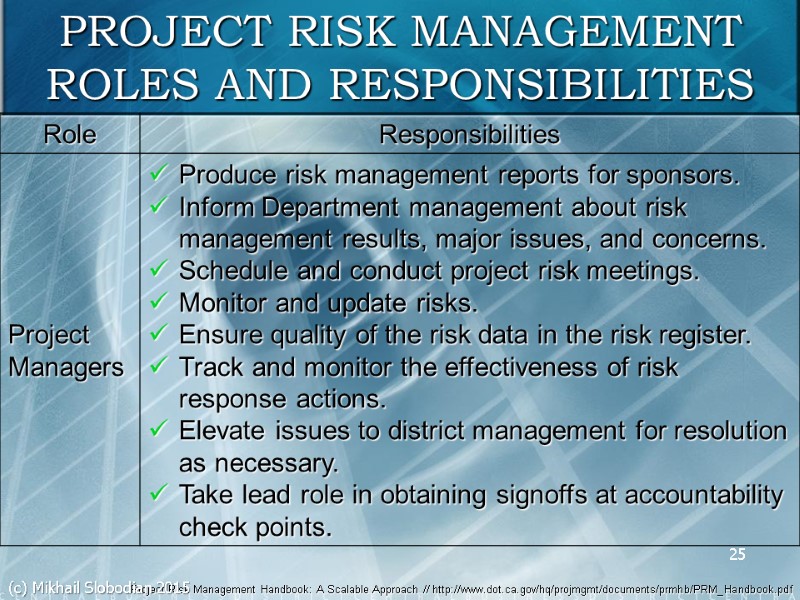

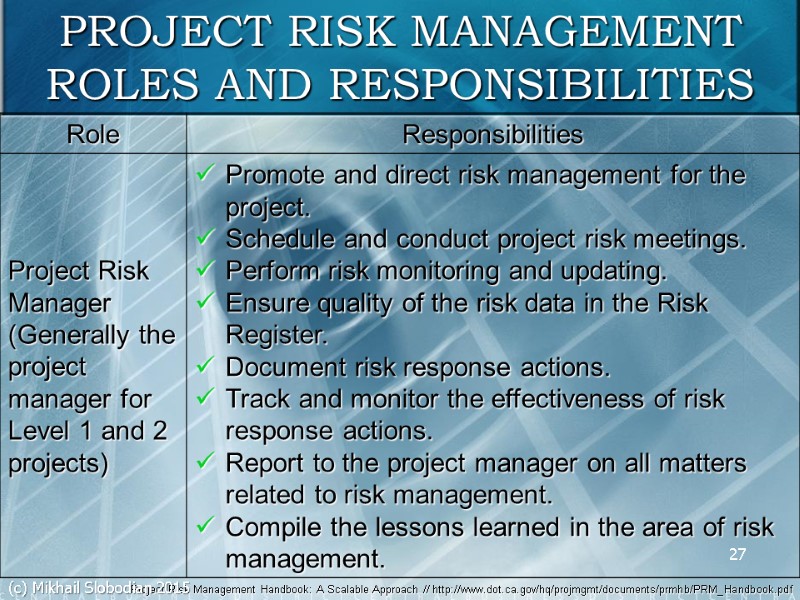
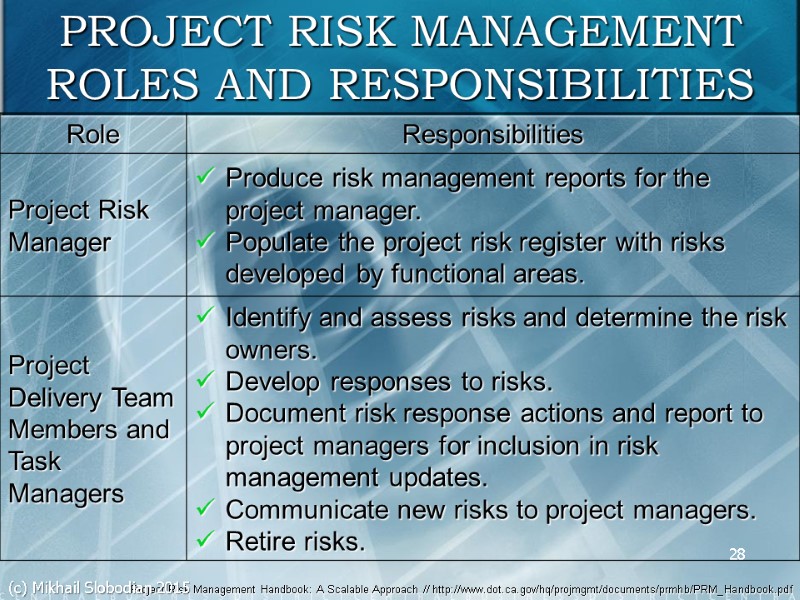
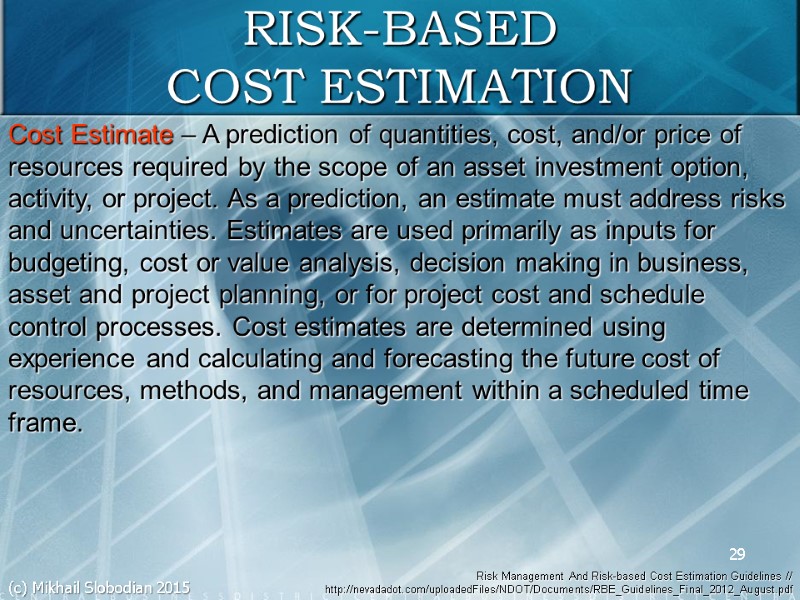
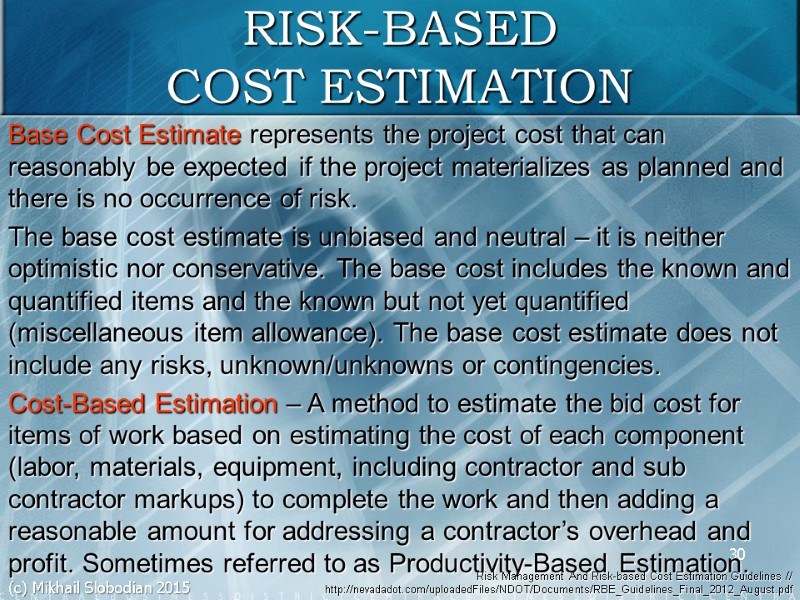
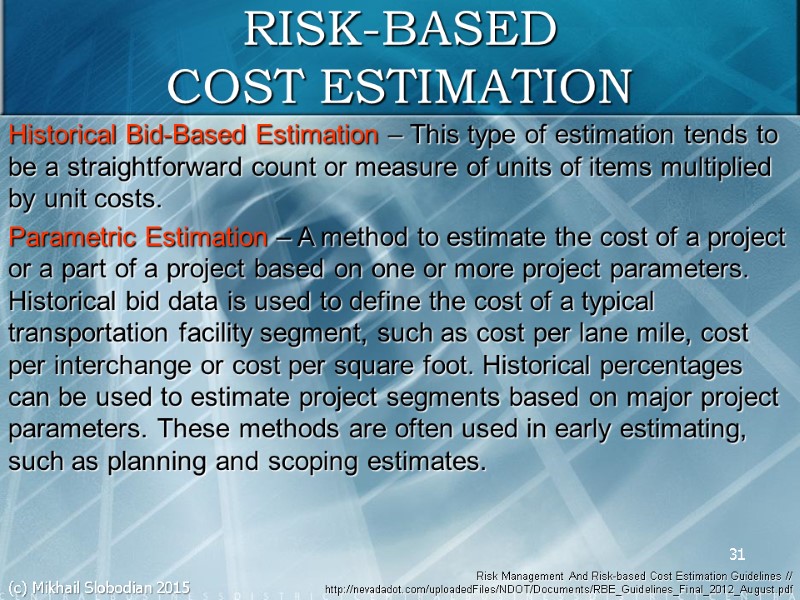
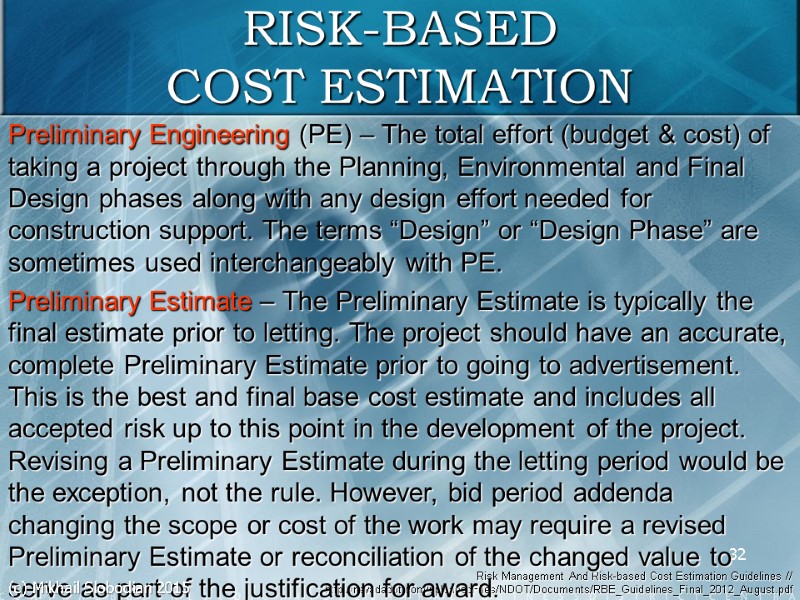
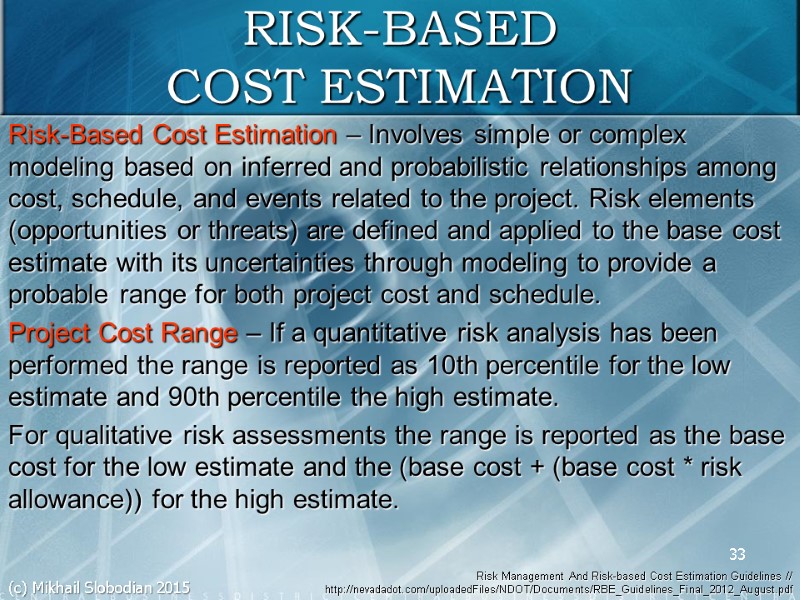
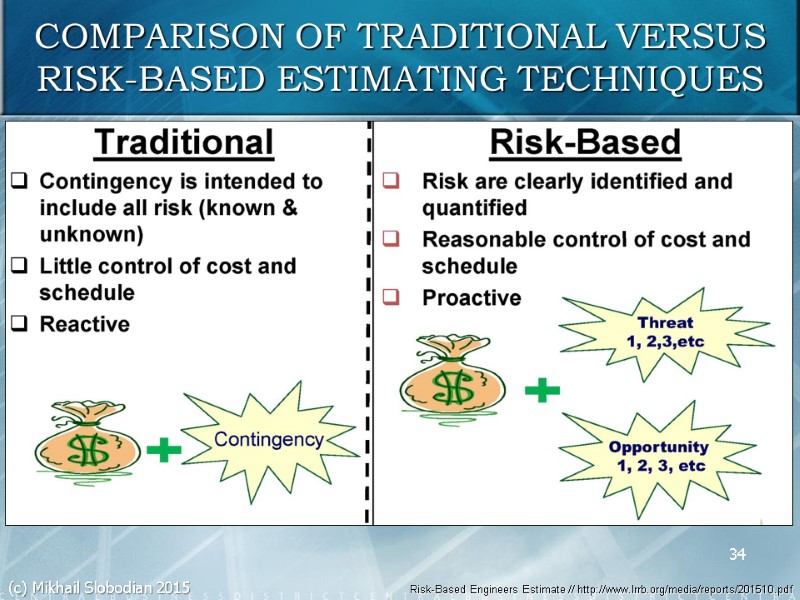
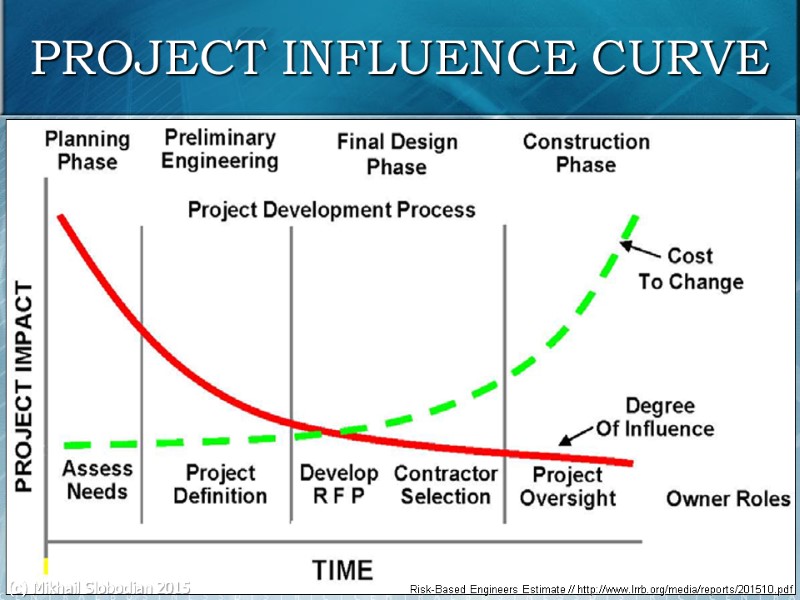
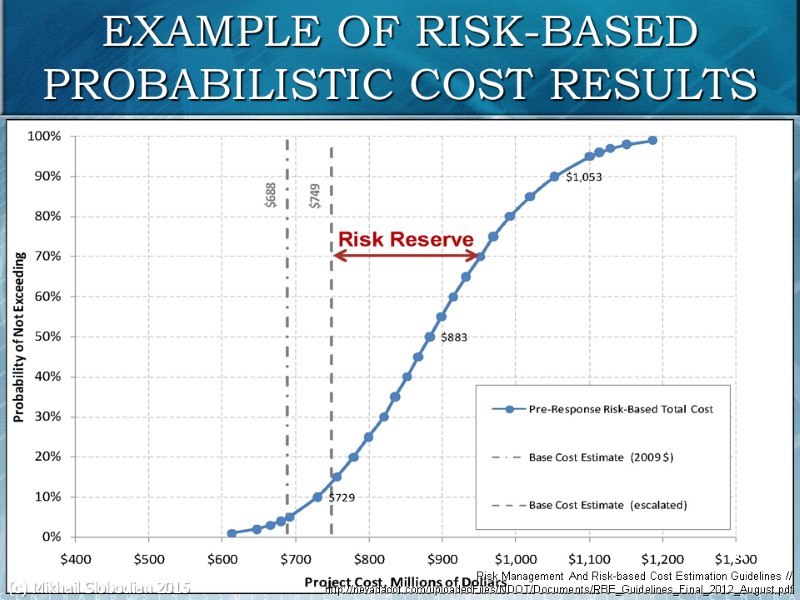
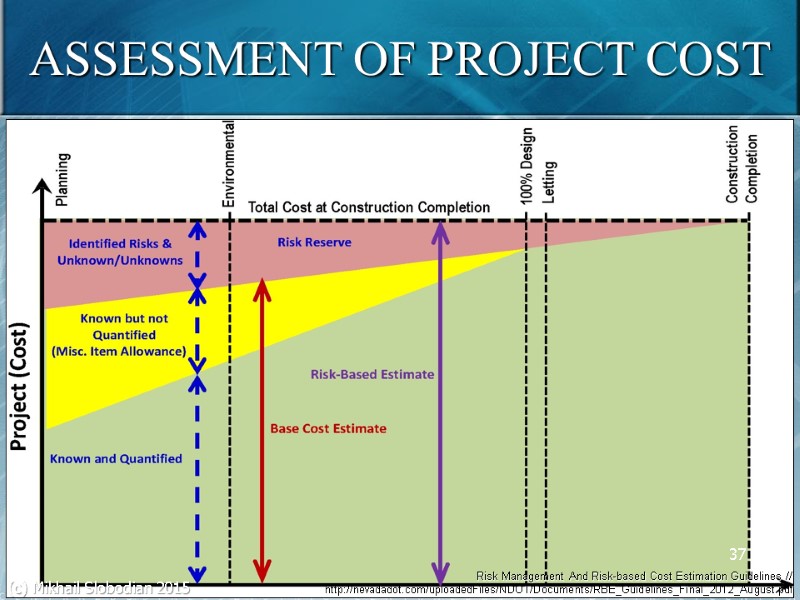
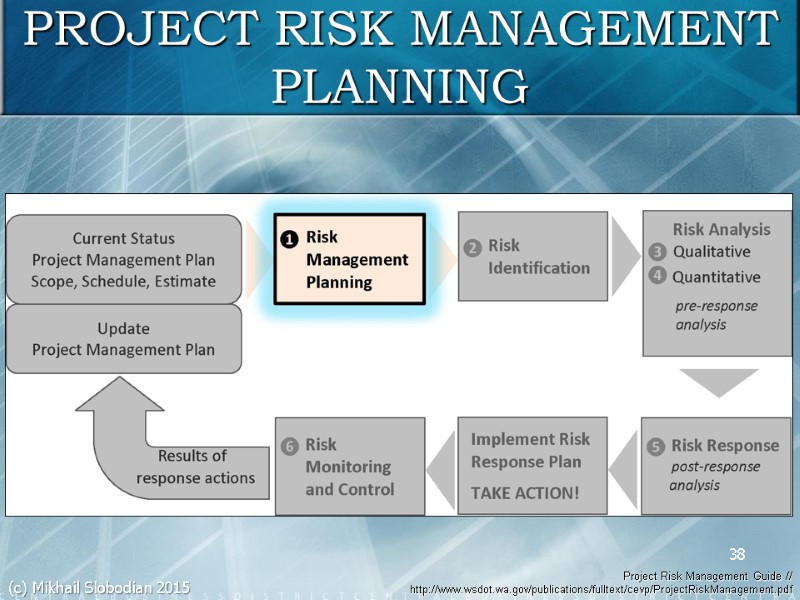
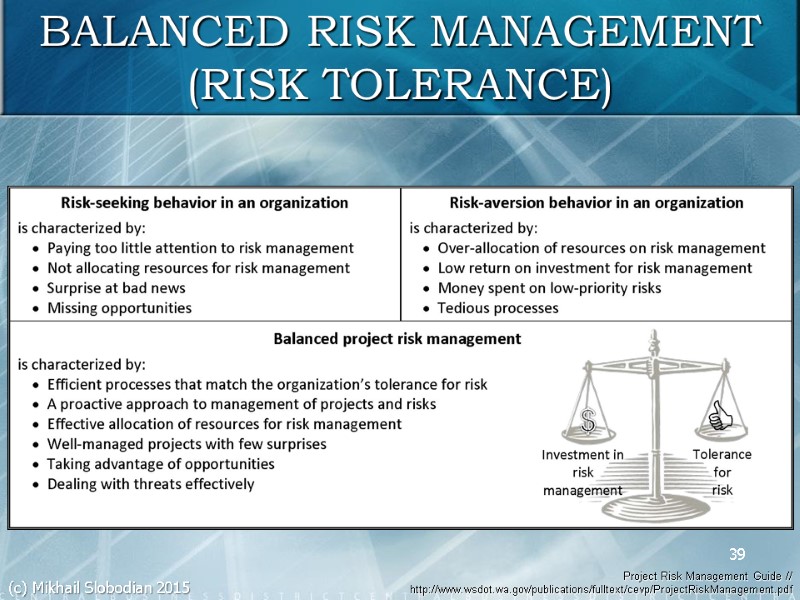
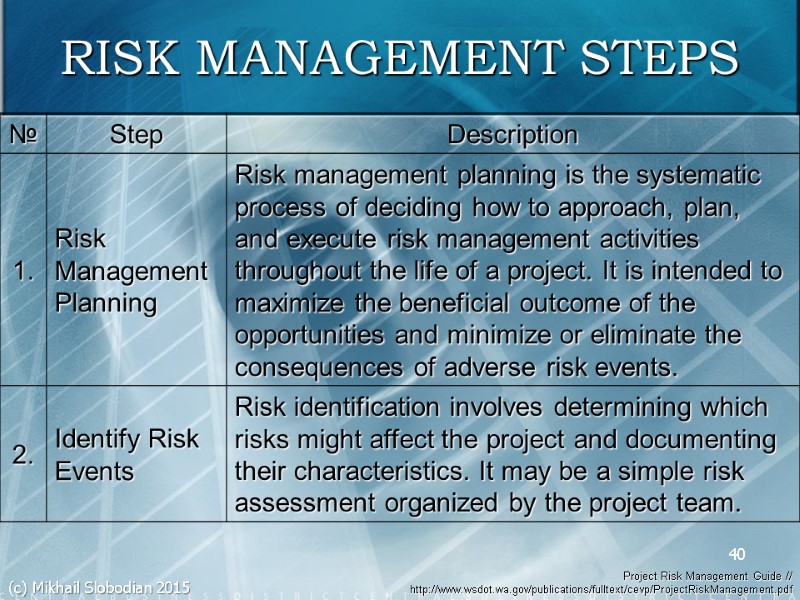
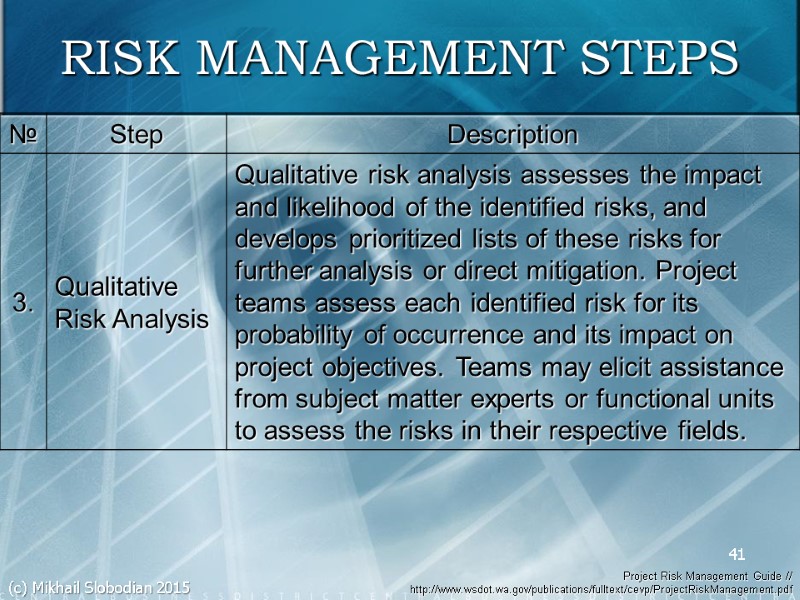
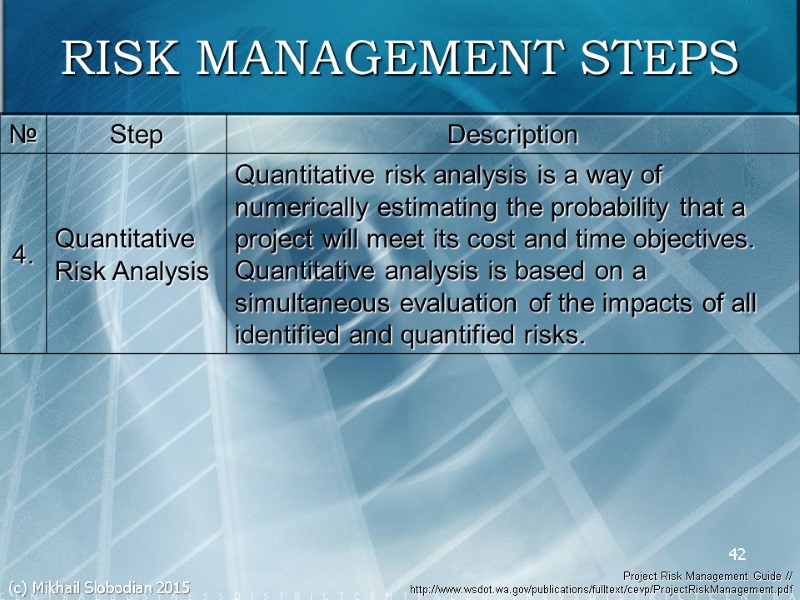
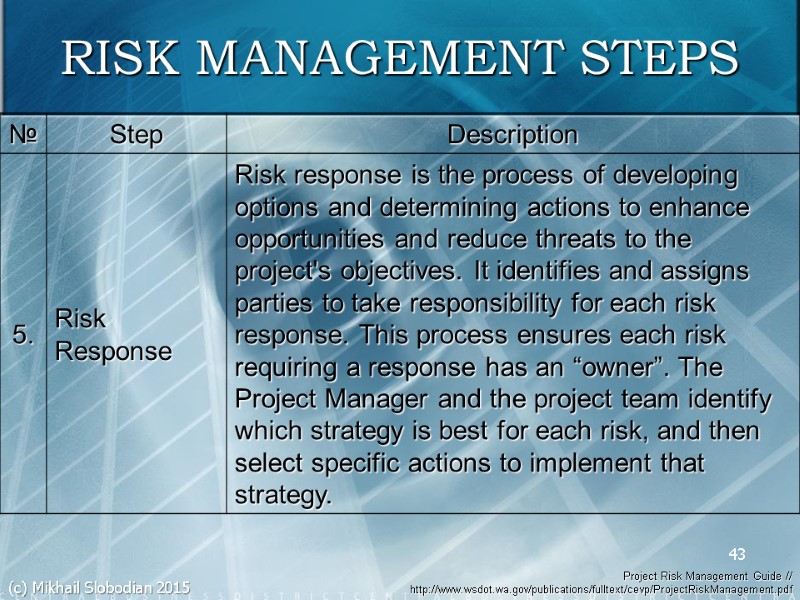
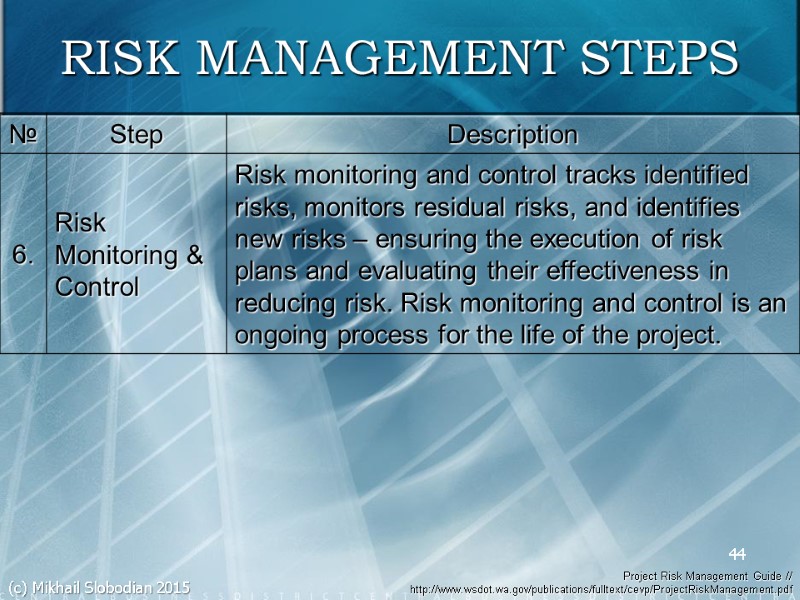
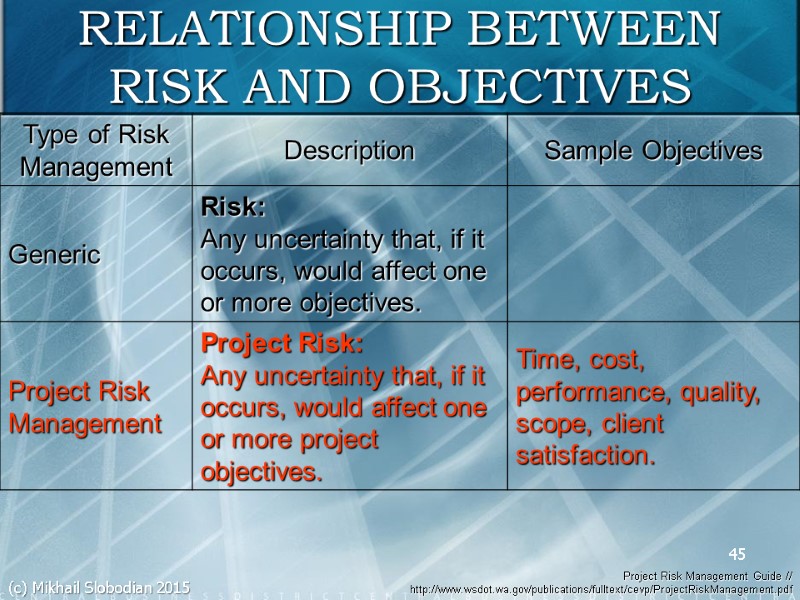
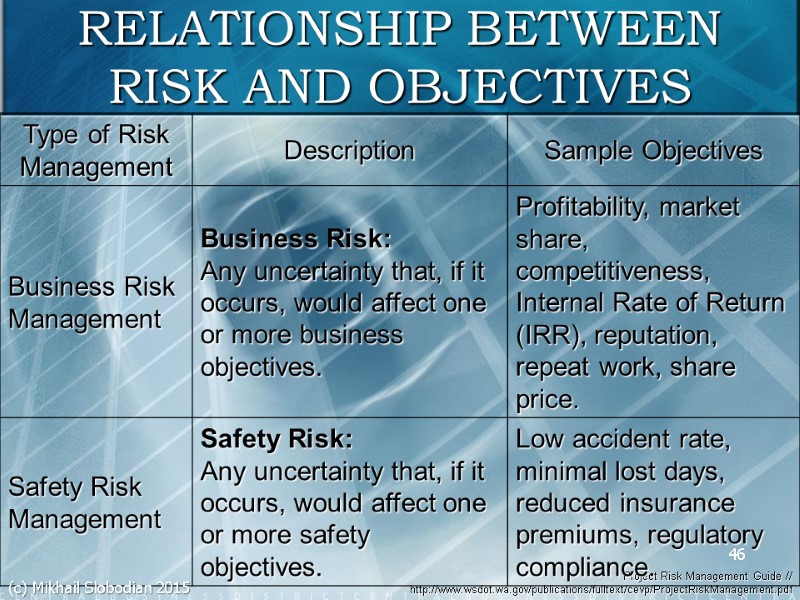
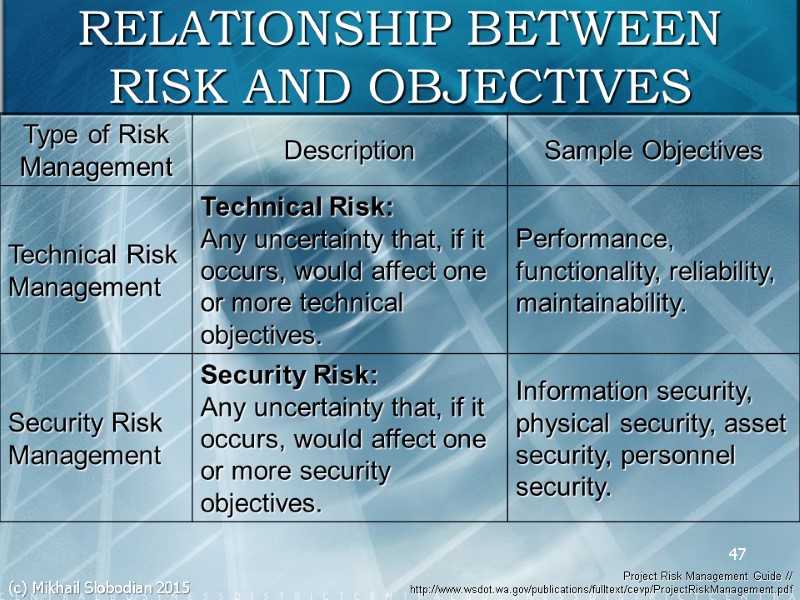
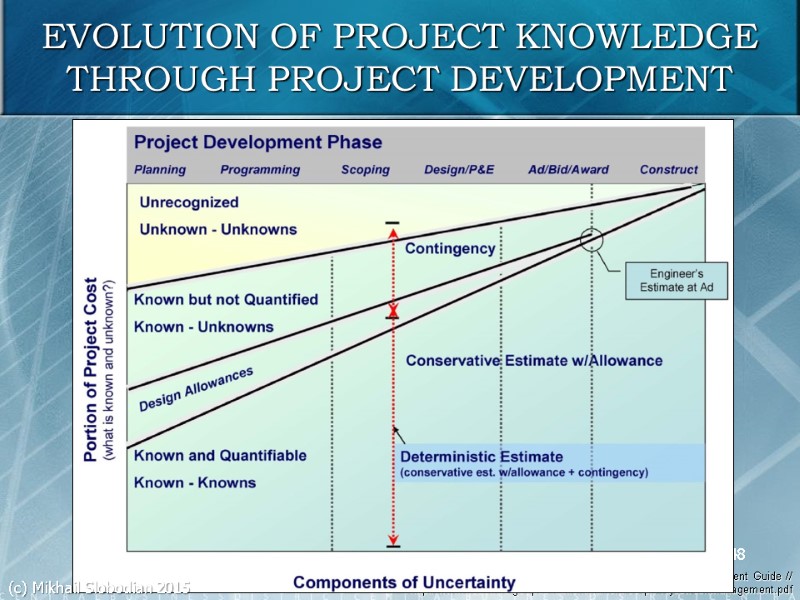
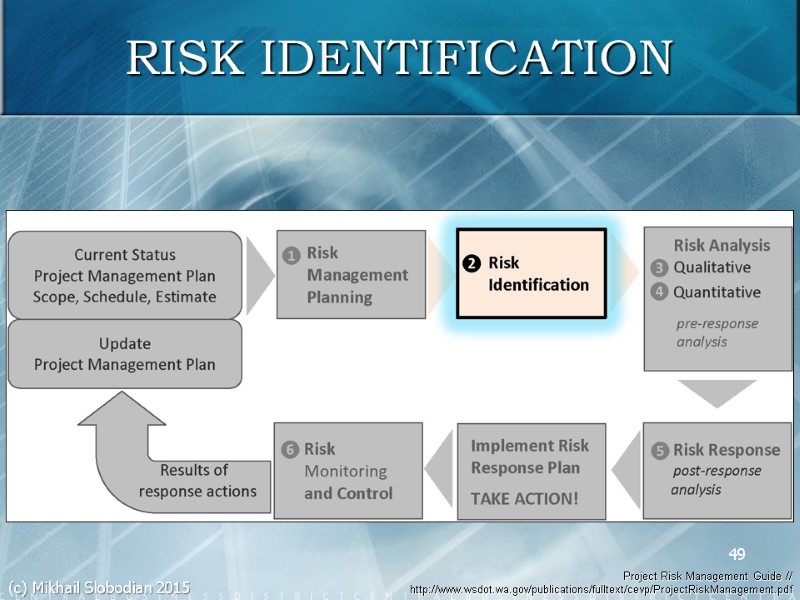
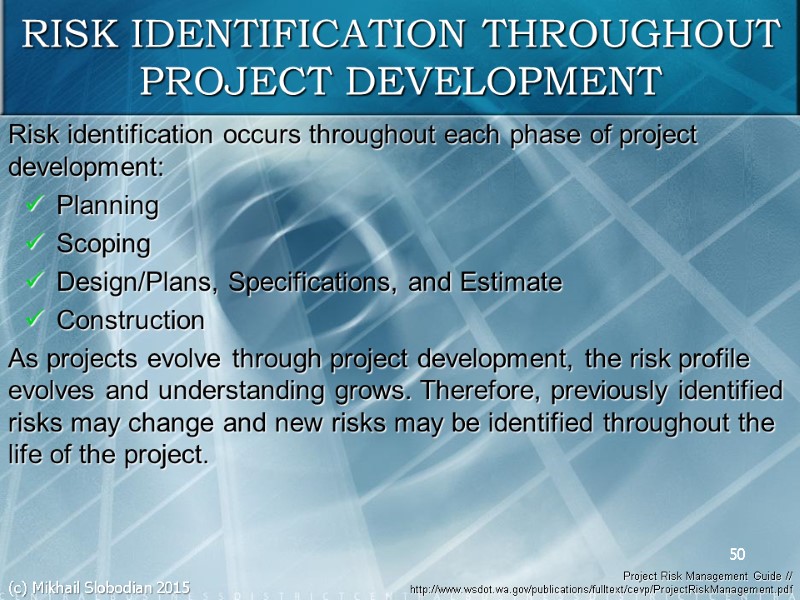
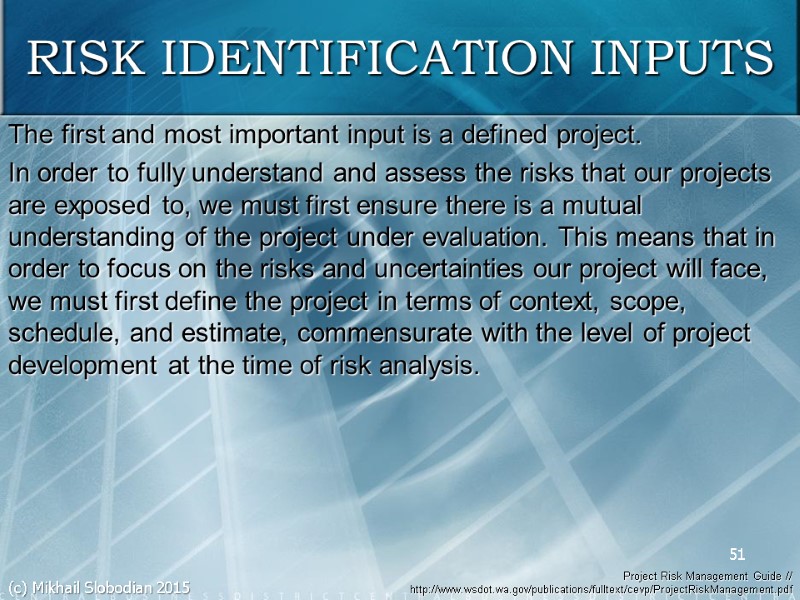
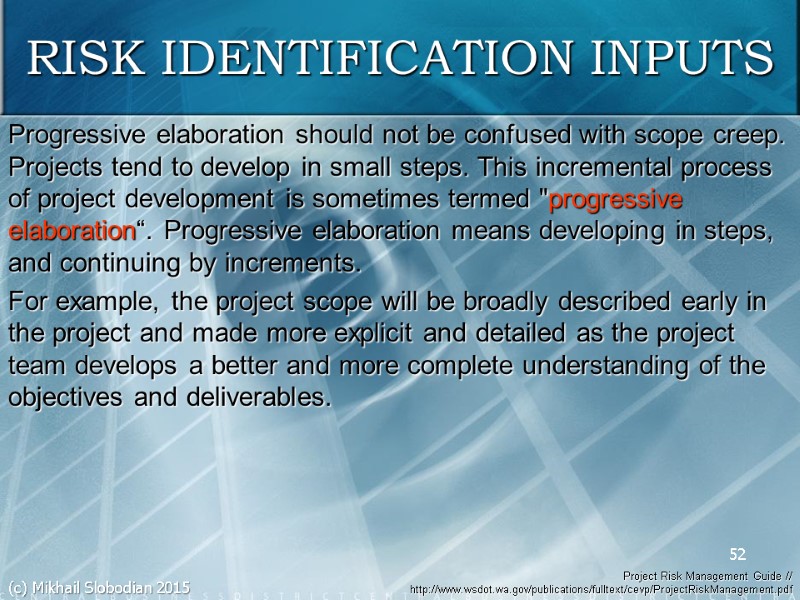
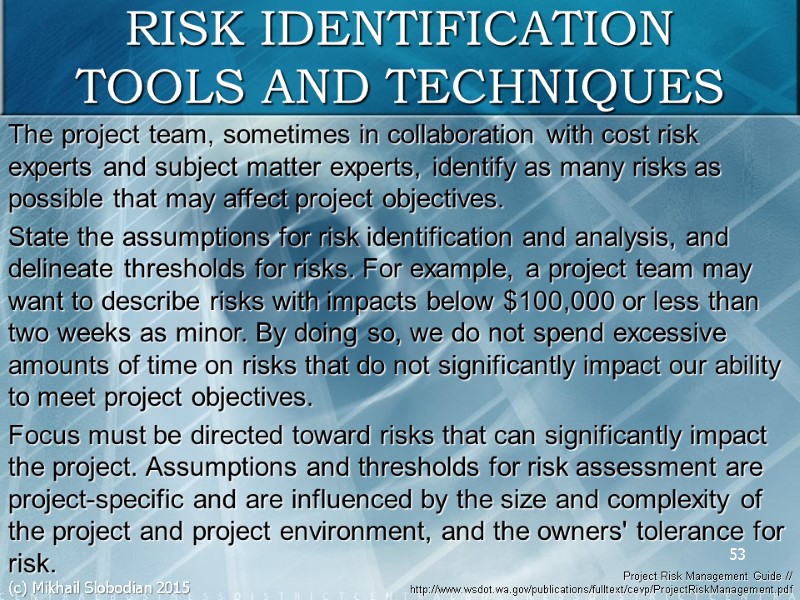
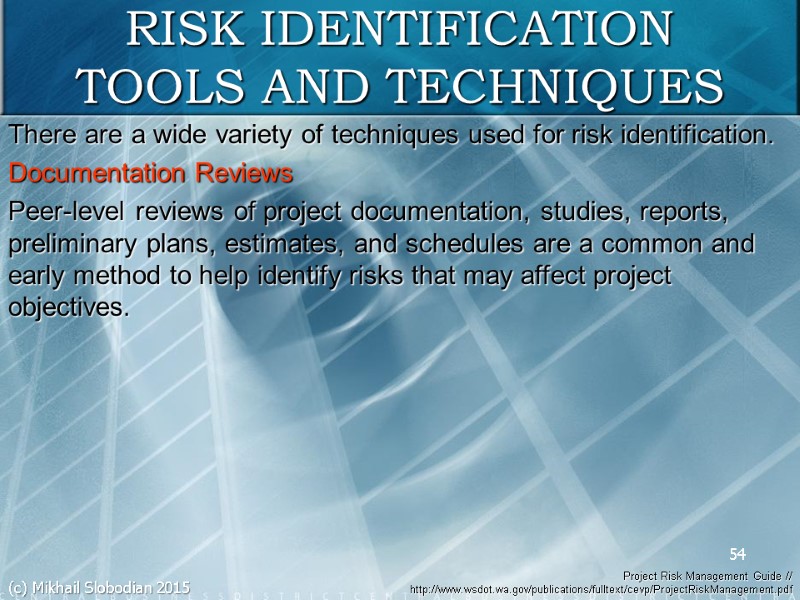
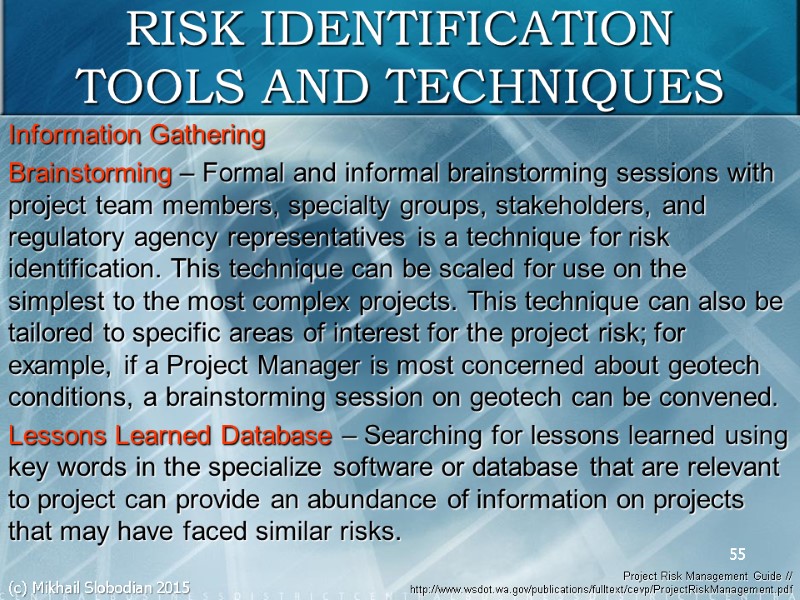
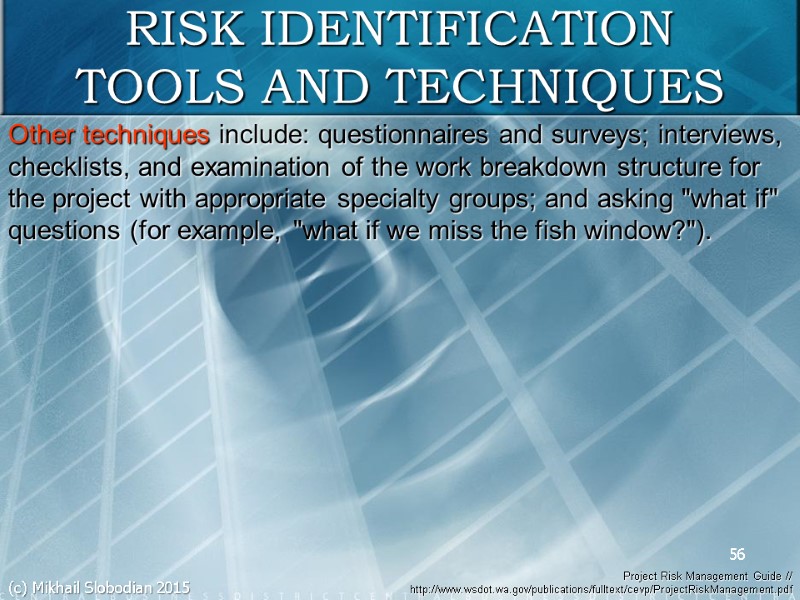
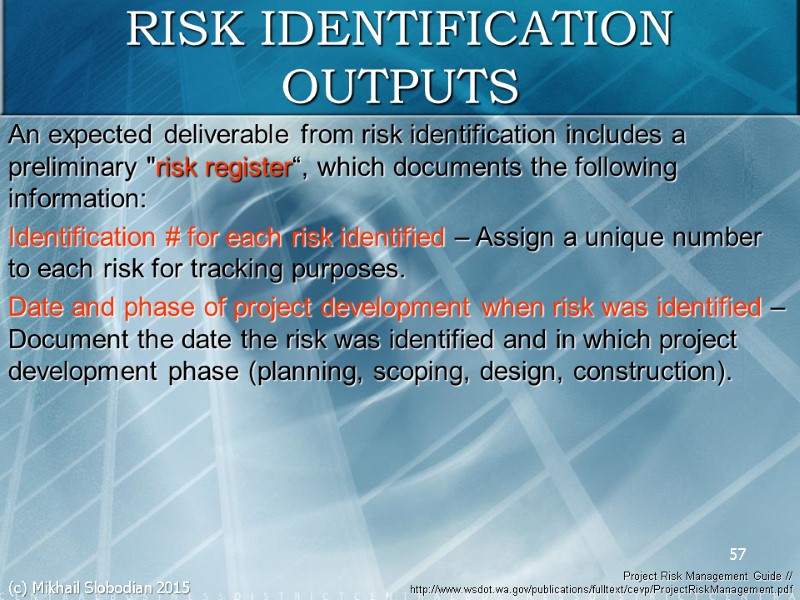
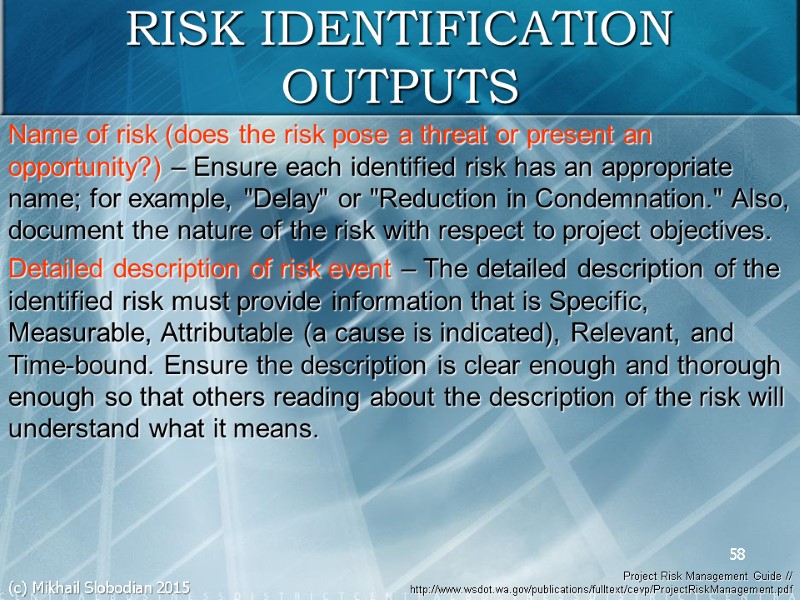
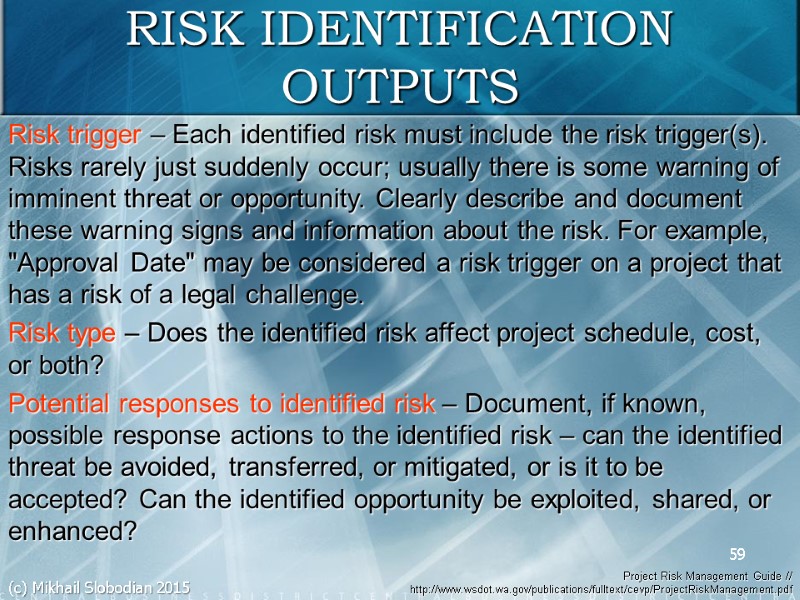
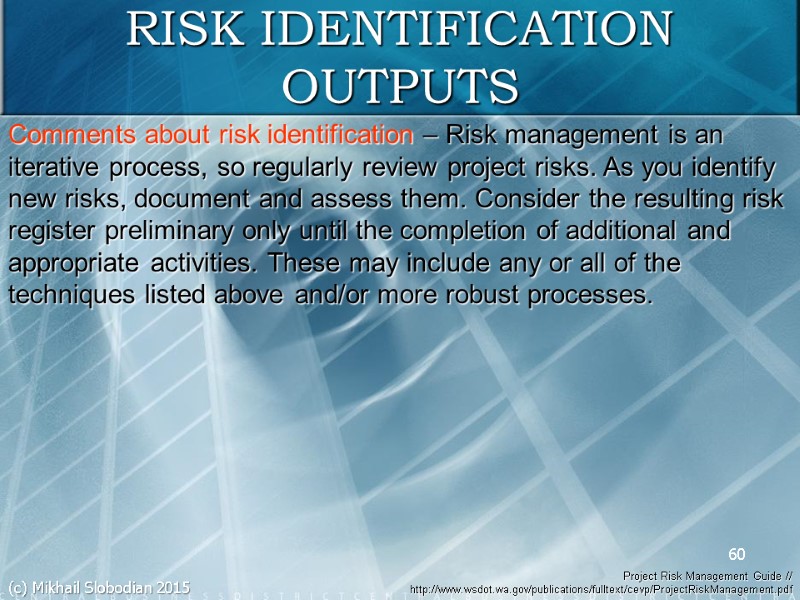
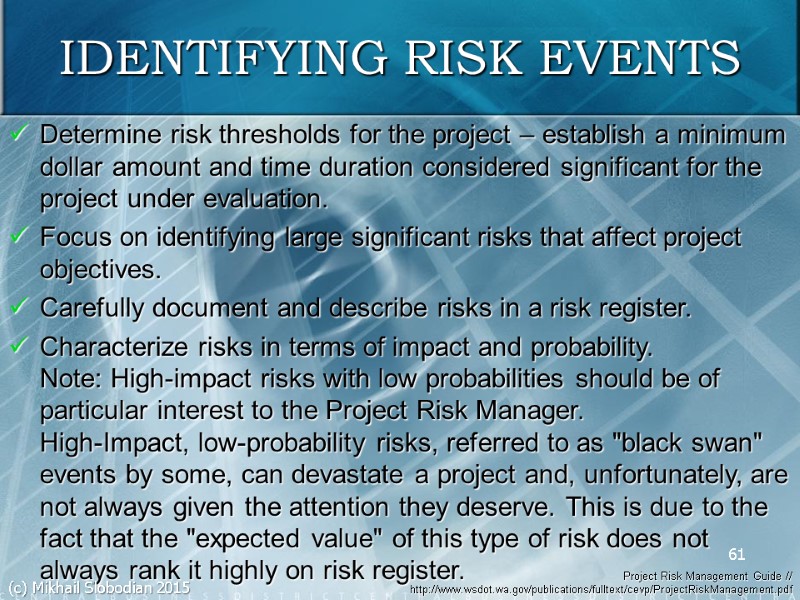
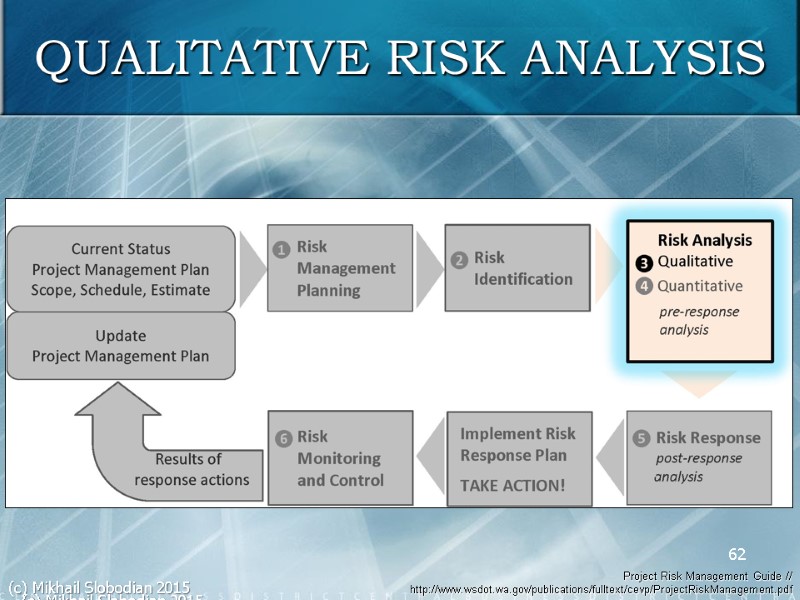
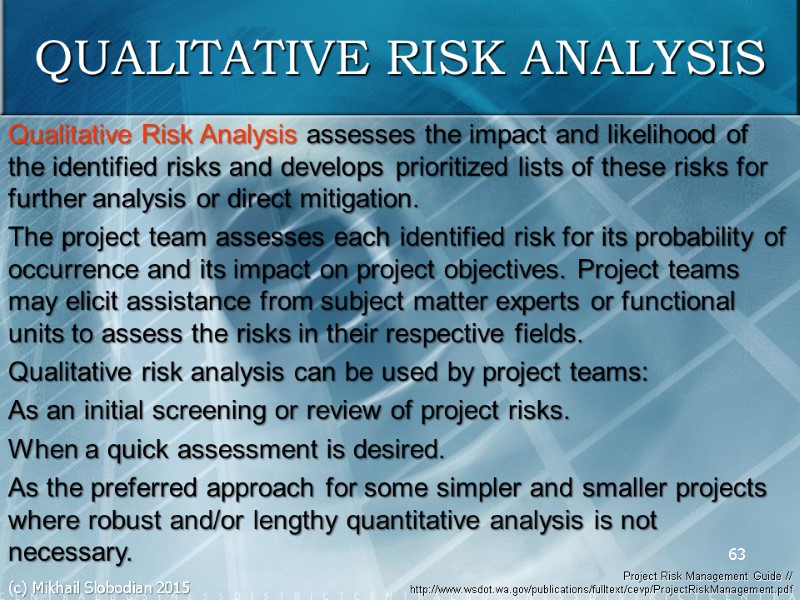
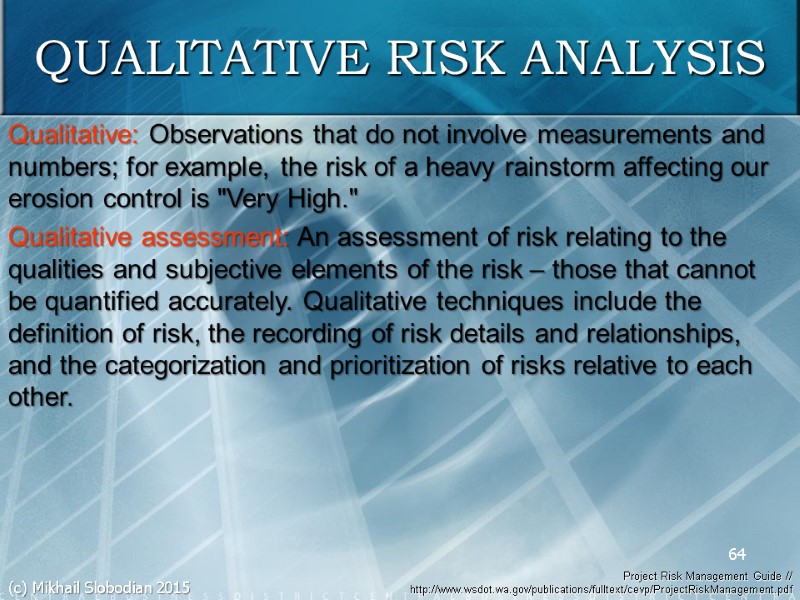
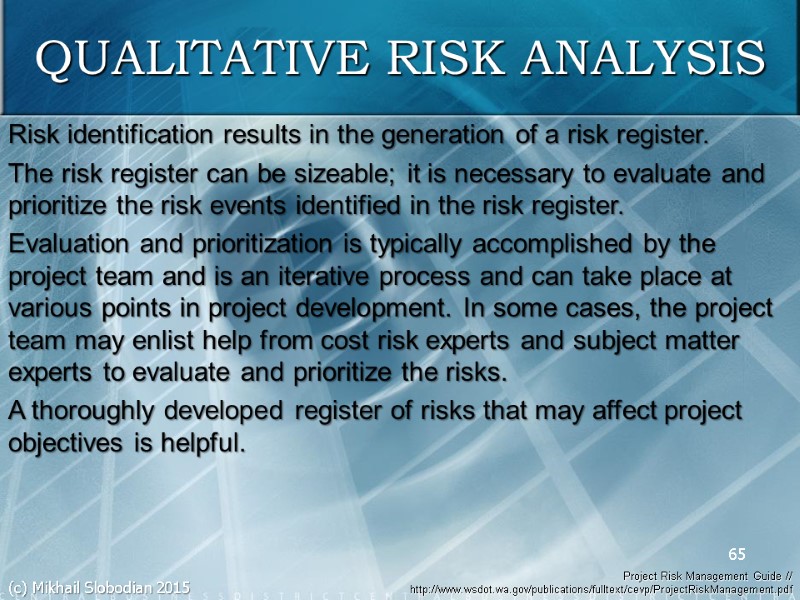
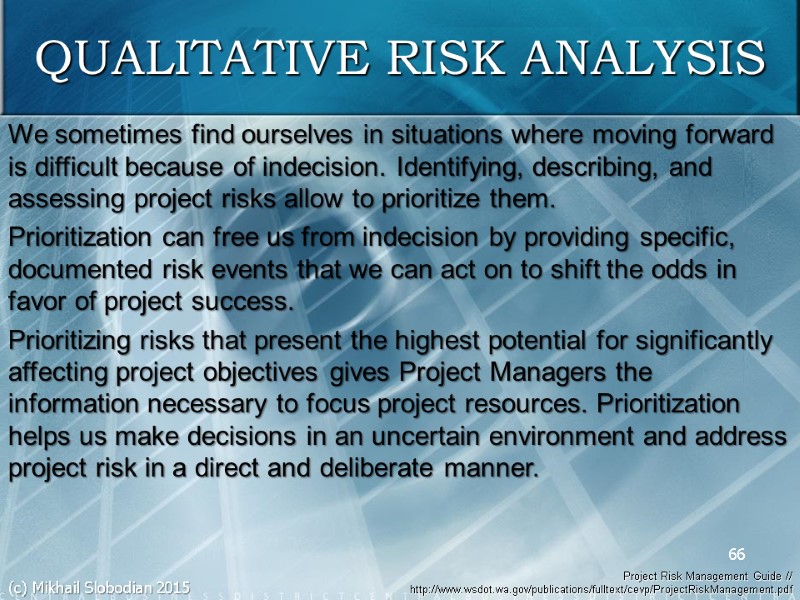
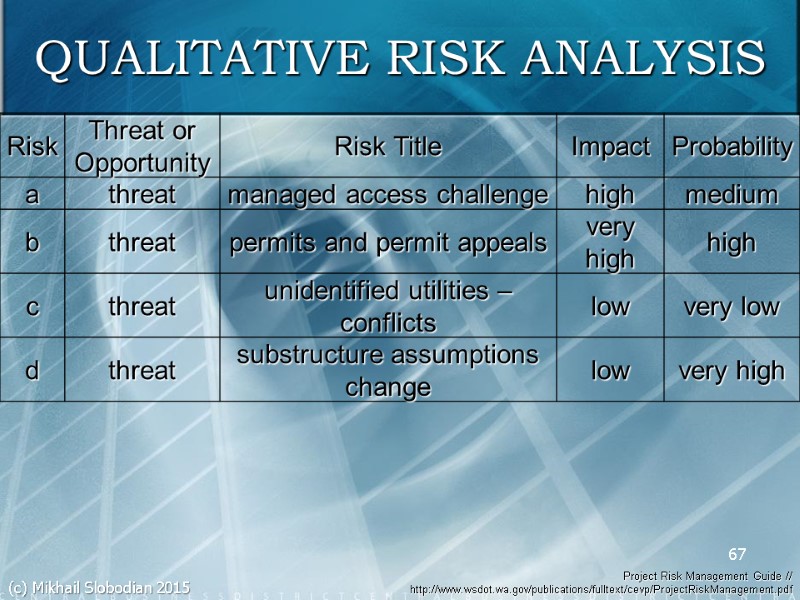
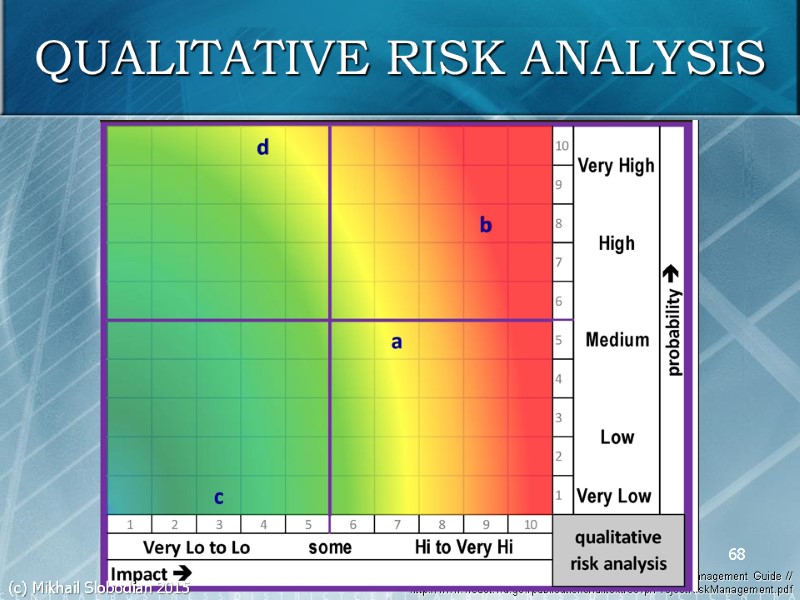
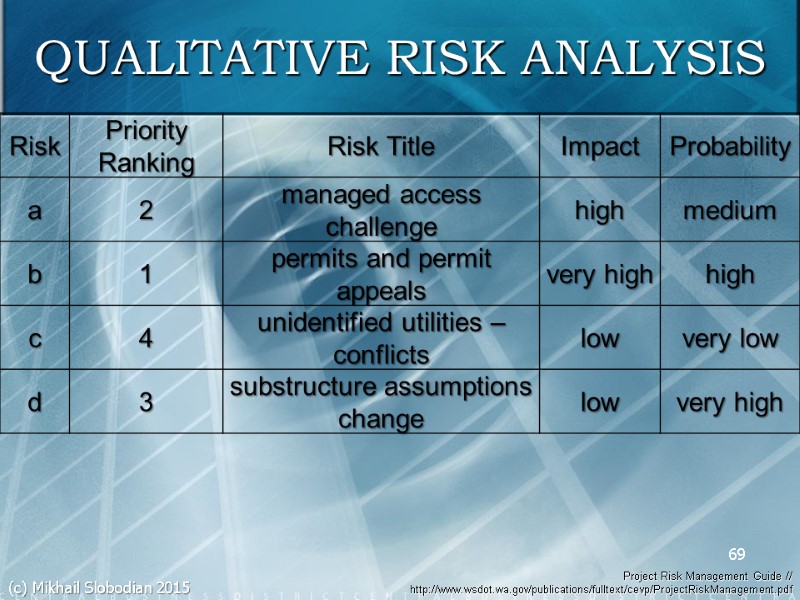
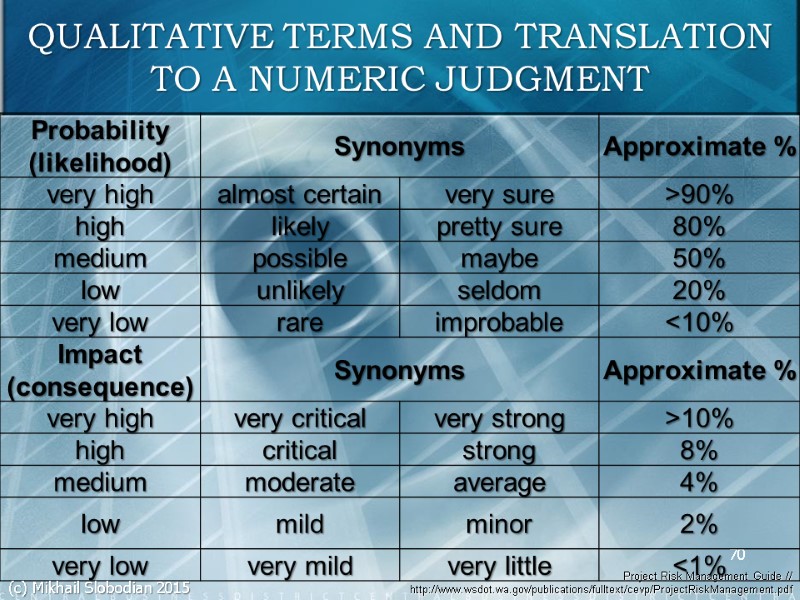
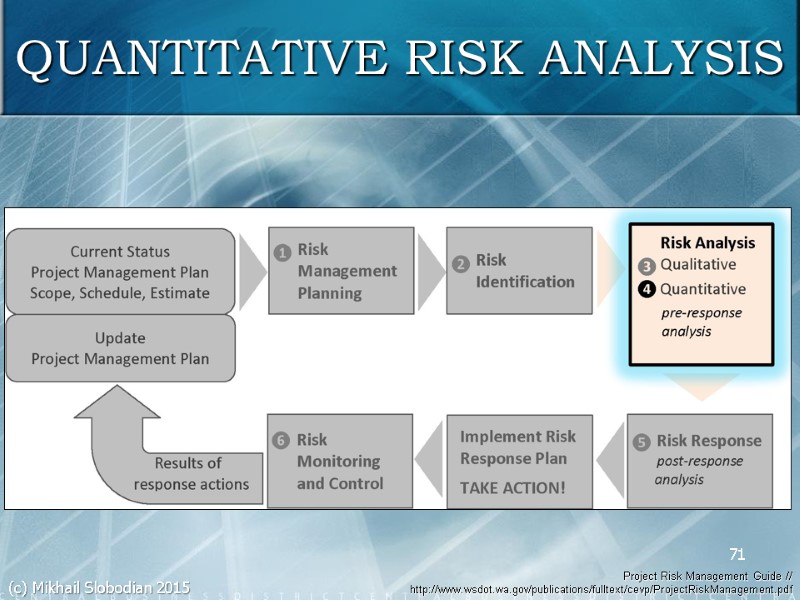
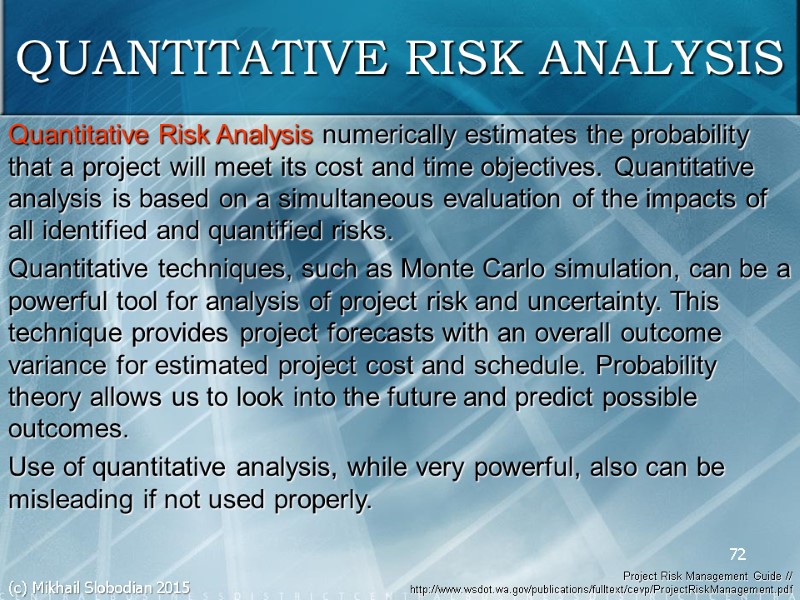
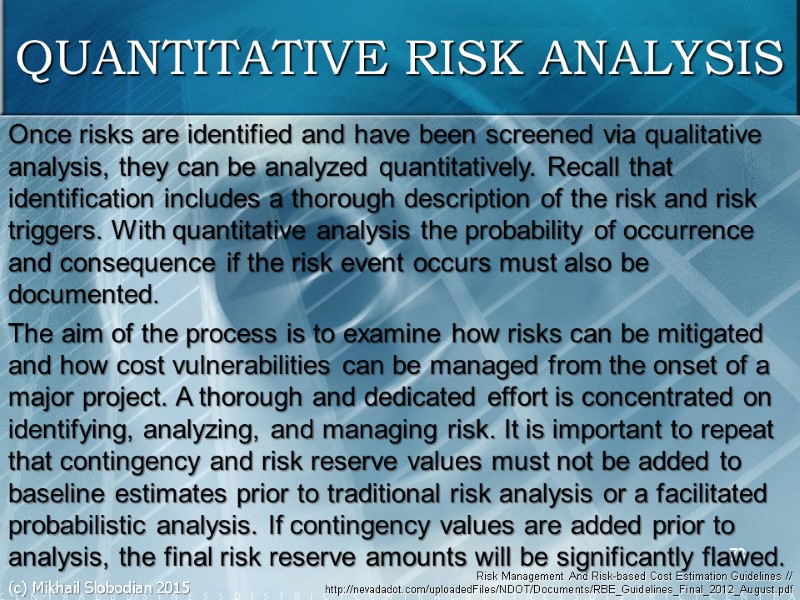
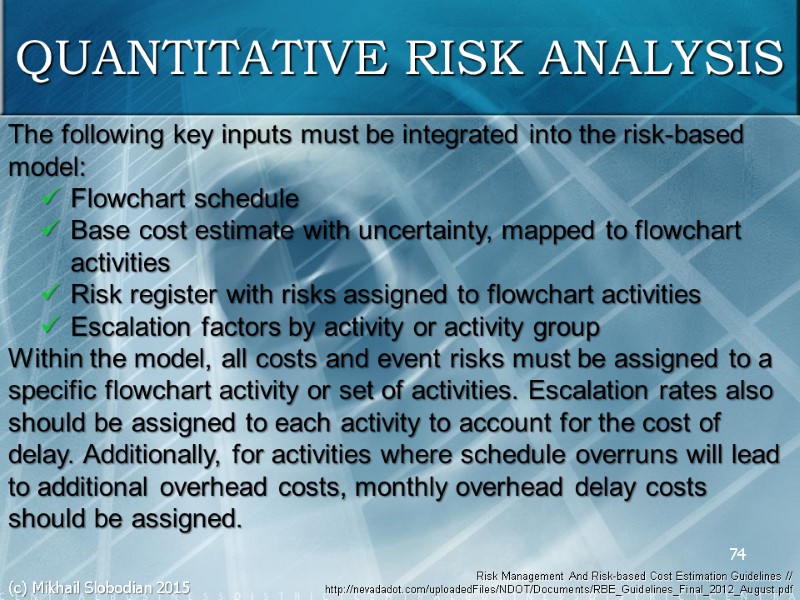

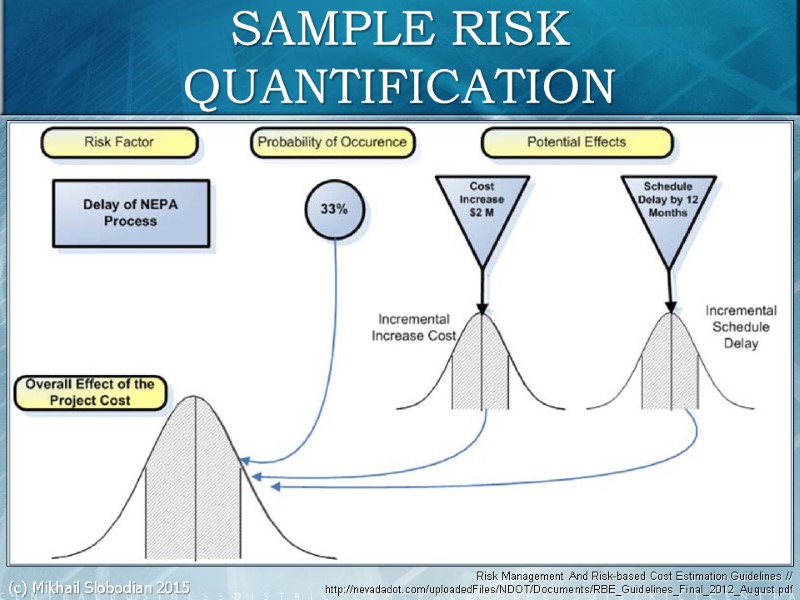
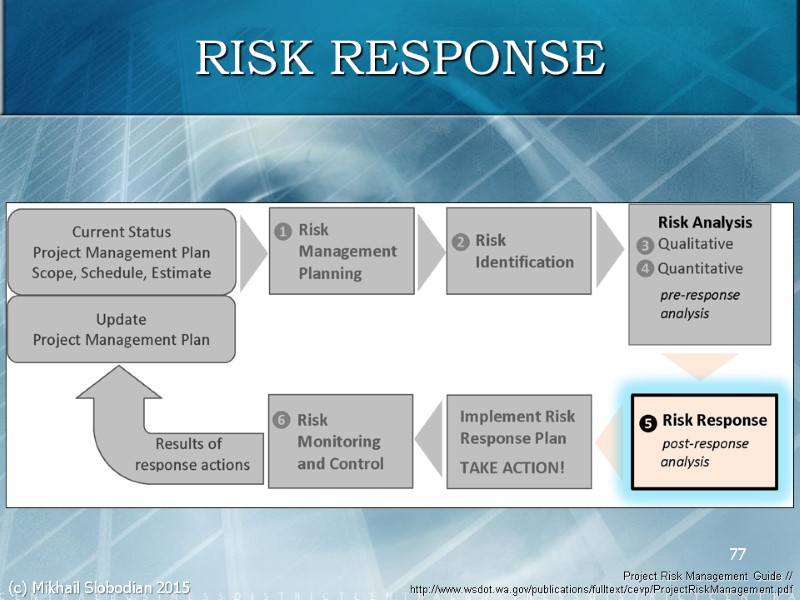
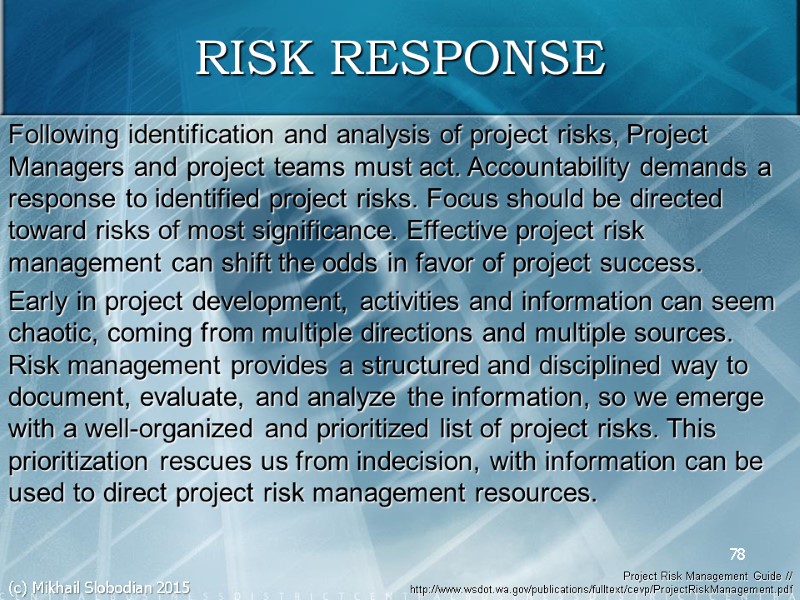
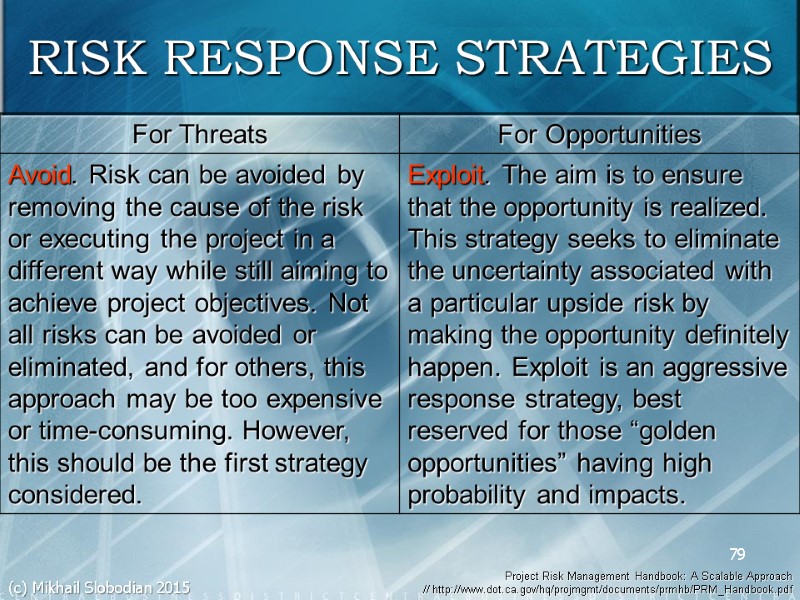
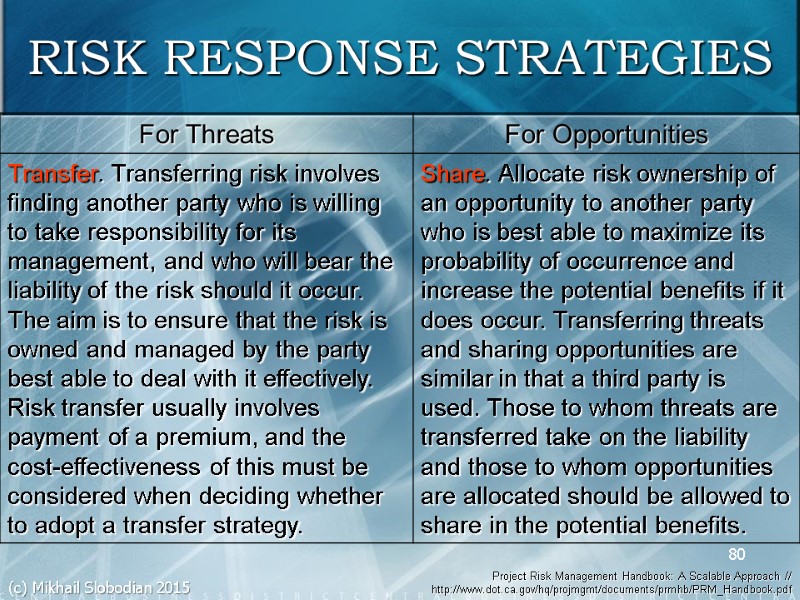
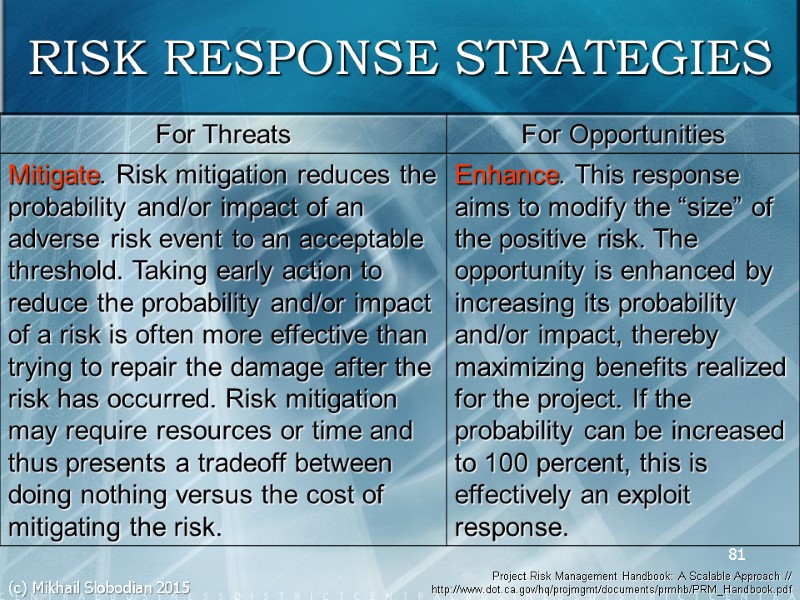
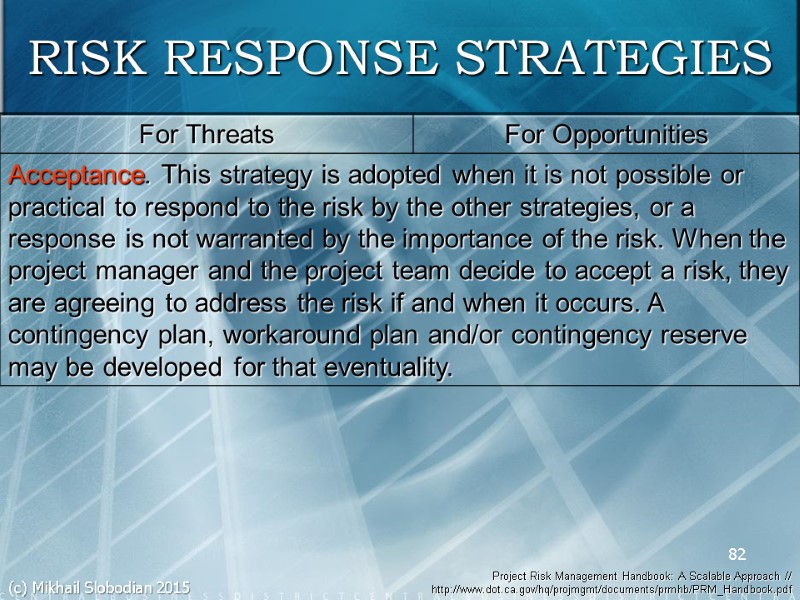
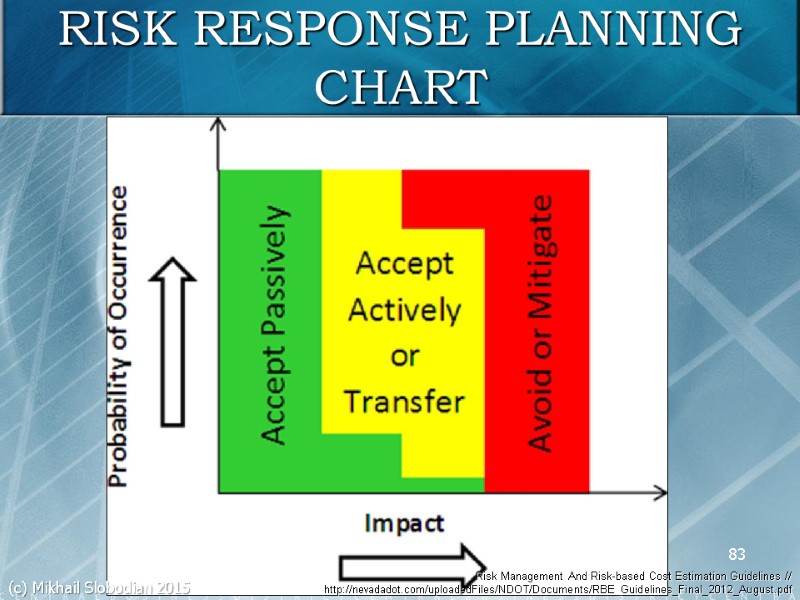
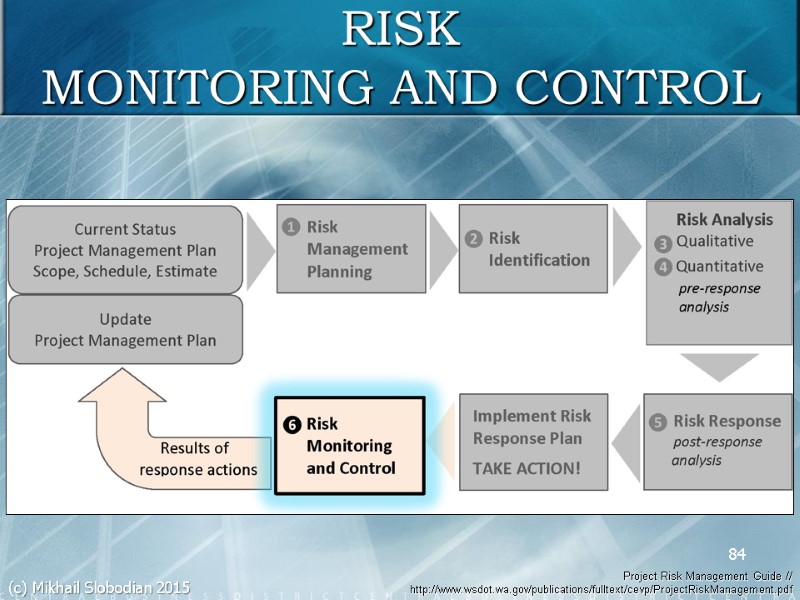
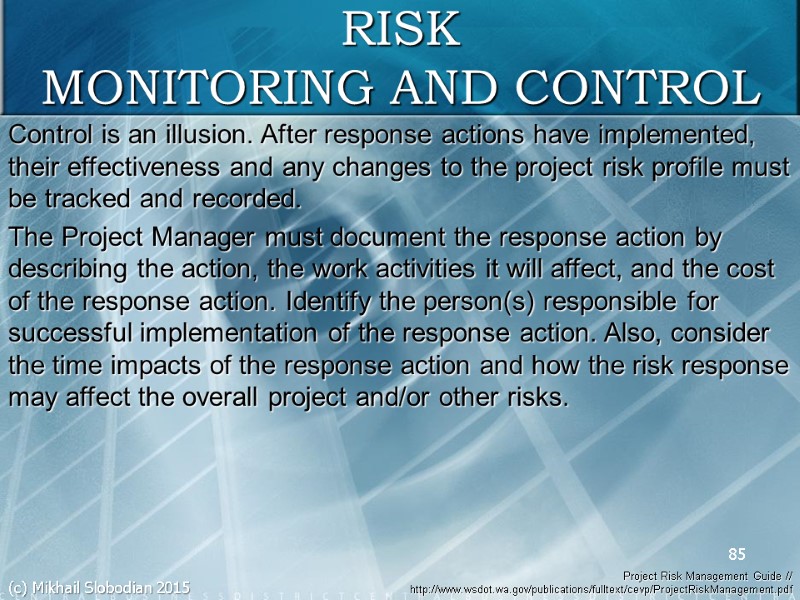
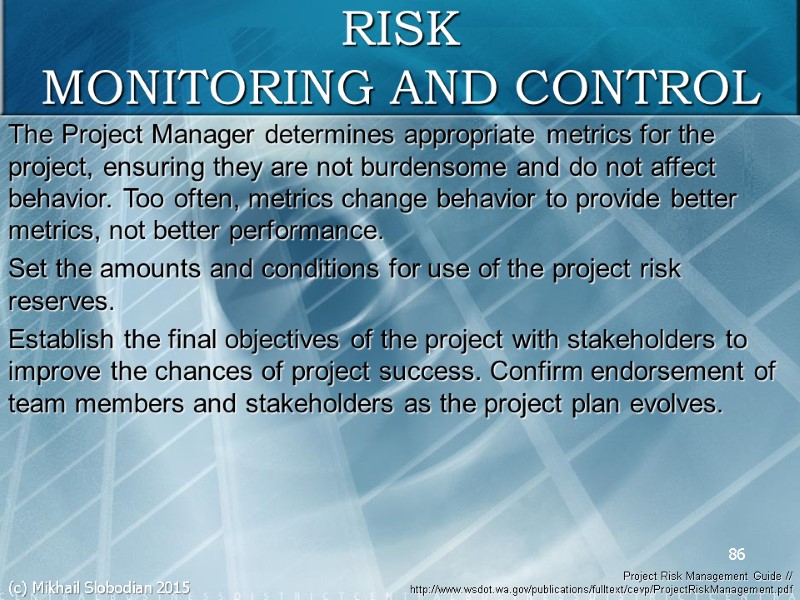
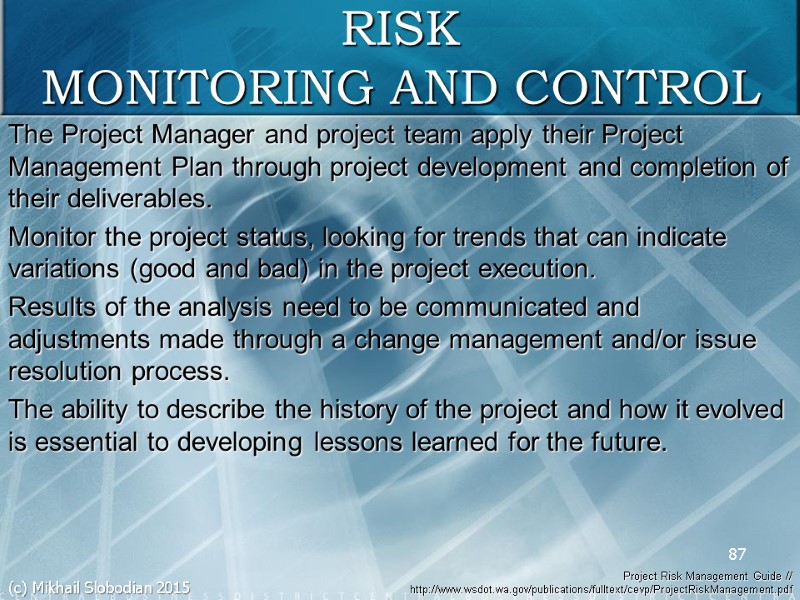
1090-05_-_risk_management_in_construction_projects.ppt
- Количество слайдов: 87
 1 RISK MANAGEMENT IN CONSTRUCTION PROJECTS (c) Mikhail Slobodian 2015
1 RISK MANAGEMENT IN CONSTRUCTION PROJECTS (c) Mikhail Slobodian 2015
 (c) Mikhail Slobodian 2015 2 THE MAIN FEATURES OF CONSTRUCTION INDUSTRY There are no identical objects. Producer goods moves from one building site to another (in contrast to many other industries). Building and construction projects transform to maintenance processes. Long lifetime of buildings and constructions (high quality and safety are needed). A lot of preliminary work (engineering survey, designing, engineering communications, matching with multiple authorities, …). Simultaneous participation of several construction organizations (complex coordination). Long construction period (complex prediction), very high cost and low liquidity of real estate property. VERY HIGH RISKS.
(c) Mikhail Slobodian 2015 2 THE MAIN FEATURES OF CONSTRUCTION INDUSTRY There are no identical objects. Producer goods moves from one building site to another (in contrast to many other industries). Building and construction projects transform to maintenance processes. Long lifetime of buildings and constructions (high quality and safety are needed). A lot of preliminary work (engineering survey, designing, engineering communications, matching with multiple authorities, …). Simultaneous participation of several construction organizations (complex coordination). Long construction period (complex prediction), very high cost and low liquidity of real estate property. VERY HIGH RISKS.
 3 PERCENTAGE OF FIRMS WITH FORMAL RISK ASSESSMENT AND MITIGATION PROCEDURES (ESTIMATED BY RESPONDENTS) Mitigation of Risk in Construction: Strategies for Reducing Risk and Maximizing Profitability // http://www.pepperlaw.com/uploads/files/mitigation_of_risk_in_construction_smr_2011.pdf (c) Mikhail Slobodian 2015
3 PERCENTAGE OF FIRMS WITH FORMAL RISK ASSESSMENT AND MITIGATION PROCEDURES (ESTIMATED BY RESPONDENTS) Mitigation of Risk in Construction: Strategies for Reducing Risk and Maximizing Profitability // http://www.pepperlaw.com/uploads/files/mitigation_of_risk_in_construction_smr_2011.pdf (c) Mikhail Slobodian 2015
 4 TIME OVERRUNS ON INFRASTRUCTURE PROJECTS Mitigation of Risk in Construction: Strategies for Reducing Risk and Maximizing Profitability // http://www.pepperlaw.com/uploads/files/mitigation_of_risk_in_construction_smr_2011.pdf (c) Mikhail Slobodian 2015
4 TIME OVERRUNS ON INFRASTRUCTURE PROJECTS Mitigation of Risk in Construction: Strategies for Reducing Risk and Maximizing Profitability // http://www.pepperlaw.com/uploads/files/mitigation_of_risk_in_construction_smr_2011.pdf (c) Mikhail Slobodian 2015
 5 BUDGET OVERRUNS ON INFRASTRUCTURE PROJECTS Mitigation of Risk in Construction: Strategies for Reducing Risk and Maximizing Profitability // http://www.pepperlaw.com/uploads/files/mitigation_of_risk_in_construction_smr_2011.pdf (c) Mikhail Slobodian 2015
5 BUDGET OVERRUNS ON INFRASTRUCTURE PROJECTS Mitigation of Risk in Construction: Strategies for Reducing Risk and Maximizing Profitability // http://www.pepperlaw.com/uploads/files/mitigation_of_risk_in_construction_smr_2011.pdf (c) Mikhail Slobodian 2015
 6 AVERAGE PERCENTAGE OF CHANGE ORDERS ON PROJECTS (c) Mikhail Slobodian 2015 Mitigation of Risk in Construction: Strategies for Reducing Risk and Maximizing Profitability // http://www.pepperlaw.com/uploads/files/mitigation_of_risk_in_construction_smr_2011.pdf
6 AVERAGE PERCENTAGE OF CHANGE ORDERS ON PROJECTS (c) Mikhail Slobodian 2015 Mitigation of Risk in Construction: Strategies for Reducing Risk and Maximizing Profitability // http://www.pepperlaw.com/uploads/files/mitigation_of_risk_in_construction_smr_2011.pdf
 7 DISPUTES OCCURRING WITH INFRASTRUCTURE PROJECTS Mitigation of Risk in Construction: Strategies for Reducing Risk and Maximizing Profitability // http://www.pepperlaw.com/uploads/files/mitigation_of_risk_in_construction_smr_2011.pdf (c) Mikhail Slobodian 2015
7 DISPUTES OCCURRING WITH INFRASTRUCTURE PROJECTS Mitigation of Risk in Construction: Strategies for Reducing Risk and Maximizing Profitability // http://www.pepperlaw.com/uploads/files/mitigation_of_risk_in_construction_smr_2011.pdf (c) Mikhail Slobodian 2015
 8 BIGGEST CONSTRUCTION RISKS (c) Mikhail Slobodian 2015 Mitigation of Risk in Construction: Strategies for Reducing Risk and Maximizing Profitability // http://www.pepperlaw.com/uploads/files/mitigation_of_risk_in_construction_smr_2011.pdf
8 BIGGEST CONSTRUCTION RISKS (c) Mikhail Slobodian 2015 Mitigation of Risk in Construction: Strategies for Reducing Risk and Maximizing Profitability // http://www.pepperlaw.com/uploads/files/mitigation_of_risk_in_construction_smr_2011.pdf
 9 BIGGEST CONSTRUCTION RISKS (c) Mikhail Slobodian 2015 Mitigation of Risk in Construction: Strategies for Reducing Risk and Maximizing Profitability // http://www.pepperlaw.com/uploads/files/mitigation_of_risk_in_construction_smr_2011.pdf
9 BIGGEST CONSTRUCTION RISKS (c) Mikhail Slobodian 2015 Mitigation of Risk in Construction: Strategies for Reducing Risk and Maximizing Profitability // http://www.pepperlaw.com/uploads/files/mitigation_of_risk_in_construction_smr_2011.pdf
 10 OVERVIEW OF PROJECT MANAGEMENT CONCEPTS AND THEIR RELATIONSHIPS (ISO 21500) (c) Mikhail Slobodian 2015
10 OVERVIEW OF PROJECT MANAGEMENT CONCEPTS AND THEIR RELATIONSHIPS (ISO 21500) (c) Mikhail Slobodian 2015
 11 PROJECT STAKEHOLDERS (ISO 21500) (c) Mikhail Slobodian 2015
11 PROJECT STAKEHOLDERS (ISO 21500) (c) Mikhail Slobodian 2015
 12 PROJECT MANAGEMENT CONCEPTS (ISO 21500) The organizational strategy identifies opportunities. The opportunities are evaluated and should be documented. Selected opportunities are further developed in a business case or other similar document, and can result in one or more projects that provide deliverables. Those deliverables can be used to realize benefits. The benefits can be an input to realizing and further developing the organizational strategy. (c) Mikhail Slobodian 2015
12 PROJECT MANAGEMENT CONCEPTS (ISO 21500) The organizational strategy identifies opportunities. The opportunities are evaluated and should be documented. Selected opportunities are further developed in a business case or other similar document, and can result in one or more projects that provide deliverables. Those deliverables can be used to realize benefits. The benefits can be an input to realizing and further developing the organizational strategy. (c) Mikhail Slobodian 2015
 13 PROJECT MANAGEMENT CONCEPTS (ISO 21500) Project management is the application of methods, tools, techniques and competencies to a project. Project management includes the integration of the various phases of the project life cycle. Project management is performed through processes. The processes selected for performing a project should be aligned in a systemic view. Each phase of the project life cycle should have specific deliverables. These deliverables should be regularly reviewed during the project to meet the requirements of the sponsor, customers and other stakeholders. (c) Mikhail Slobodian 2015
13 PROJECT MANAGEMENT CONCEPTS (ISO 21500) Project management is the application of methods, tools, techniques and competencies to a project. Project management includes the integration of the various phases of the project life cycle. Project management is performed through processes. The processes selected for performing a project should be aligned in a systemic view. Each phase of the project life cycle should have specific deliverables. These deliverables should be regularly reviewed during the project to meet the requirements of the sponsor, customers and other stakeholders. (c) Mikhail Slobodian 2015
 14 PROCESS GROUP INTERACTIONS SHOWING REPRESENTATIVE INPUTS AND OUTPUTS (ISO21500) (c) Mikhail Slobodian 2015
14 PROCESS GROUP INTERACTIONS SHOWING REPRESENTATIVE INPUTS AND OUTPUTS (ISO21500) (c) Mikhail Slobodian 2015
 15 PROCESS GROUP PROCESSES MAPPED TO SUBJECT GROUPS (ISO 21500) (c) Mikhail Slobodian 2015
15 PROCESS GROUP PROCESSES MAPPED TO SUBJECT GROUPS (ISO 21500) (c) Mikhail Slobodian 2015
 16 PROCESS GROUP PROCESSES MAPPED TO SUBJECT GROUPS (ISO 21500) WBS – work breakdown structure (c) Mikhail Slobodian 2015
16 PROCESS GROUP PROCESSES MAPPED TO SUBJECT GROUPS (ISO 21500) WBS – work breakdown structure (c) Mikhail Slobodian 2015
 17 PROCESS GROUP PROCESSES MAPPED TO SUBJECT GROUPS (ISO 21500) (c) Mikhail Slobodian 2015
17 PROCESS GROUP PROCESSES MAPPED TO SUBJECT GROUPS (ISO 21500) (c) Mikhail Slobodian 2015
 18 PROCESS GROUP PROCESSES MAPPED TO SUBJECT GROUPS (ISO 21500) (c) Mikhail Slobodian 2015
18 PROCESS GROUP PROCESSES MAPPED TO SUBJECT GROUPS (ISO 21500) (c) Mikhail Slobodian 2015
 19 PROCESS GROUP PROCESSES MAPPED TO SUBJECT GROUPS (ISO 21500) (c) Mikhail Slobodian 2015
19 PROCESS GROUP PROCESSES MAPPED TO SUBJECT GROUPS (ISO 21500) (c) Mikhail Slobodian 2015
 20 PROJECT RISK MANAGEMENT VALUES Identifying, communicating, and managing project risks requires a risk management culture. This culture is defined by the values in which staff are operated. The following attributes depict project risk management values required for the development of a successful risk management culture: Risk decision-making based on balancing project values such as cost, schedule, and quality Stewardship Efficiency Teamwork Joint ownership of risks and responsibilities Accountability Project Risk Management Handbook: A Scalable Approach // http://www.dot.ca.gov/hq/projmgmt/documents/prmhb/PRM_Handbook.pdf (c) Mikhail Slobodian 2015
20 PROJECT RISK MANAGEMENT VALUES Identifying, communicating, and managing project risks requires a risk management culture. This culture is defined by the values in which staff are operated. The following attributes depict project risk management values required for the development of a successful risk management culture: Risk decision-making based on balancing project values such as cost, schedule, and quality Stewardship Efficiency Teamwork Joint ownership of risks and responsibilities Accountability Project Risk Management Handbook: A Scalable Approach // http://www.dot.ca.gov/hq/projmgmt/documents/prmhb/PRM_Handbook.pdf (c) Mikhail Slobodian 2015
 21 RISK MANAGEMENT REQUIREMENTS BY SCALABILITY LEVEL (c) Mikhail Slobodian 2015 Project Risk Management Handbook: A Scalable Approach // http://www.dot.ca.gov/hq/projmgmt/documents/prmhb/PRM_Handbook.pdf
21 RISK MANAGEMENT REQUIREMENTS BY SCALABILITY LEVEL (c) Mikhail Slobodian 2015 Project Risk Management Handbook: A Scalable Approach // http://www.dot.ca.gov/hq/projmgmt/documents/prmhb/PRM_Handbook.pdf
 22 LEVELS OF PROJECT RISK MANAGEMENT SCALABILITY Project Risk Management Handbook: A Scalable Approach // http://www.dot.ca.gov/hq/projmgmt/documents/prmhb/PRM_Handbook.pdf (c) Mikhail Slobodian 2015
22 LEVELS OF PROJECT RISK MANAGEMENT SCALABILITY Project Risk Management Handbook: A Scalable Approach // http://www.dot.ca.gov/hq/projmgmt/documents/prmhb/PRM_Handbook.pdf (c) Mikhail Slobodian 2015
 23 PROJECT MANAGEMENT – INTEGRATES PROJECT RISK MANAGEMENT Project Risk Management Guide // http://www.wsdot.wa.gov/publications/fulltext/cevp/ProjectRiskManagement.pdf (c) Mikhail Slobodian 2015
23 PROJECT MANAGEMENT – INTEGRATES PROJECT RISK MANAGEMENT Project Risk Management Guide // http://www.wsdot.wa.gov/publications/fulltext/cevp/ProjectRiskManagement.pdf (c) Mikhail Slobodian 2015
 (c) Mikhail Slobodian 2015 24 PROJECT RISK MANAGEMENT ROLES AND RESPONSIBILITIES Project Risk Management Handbook: A Scalable Approach // http://www.dot.ca.gov/hq/projmgmt/documents/prmhb/PRM_Handbook.pdf
(c) Mikhail Slobodian 2015 24 PROJECT RISK MANAGEMENT ROLES AND RESPONSIBILITIES Project Risk Management Handbook: A Scalable Approach // http://www.dot.ca.gov/hq/projmgmt/documents/prmhb/PRM_Handbook.pdf
 25 PROJECT RISK MANAGEMENT ROLES AND RESPONSIBILITIES Project Risk Management Handbook: A Scalable Approach // http://www.dot.ca.gov/hq/projmgmt/documents/prmhb/PRM_Handbook.pdf (c) Mikhail Slobodian 2015
25 PROJECT RISK MANAGEMENT ROLES AND RESPONSIBILITIES Project Risk Management Handbook: A Scalable Approach // http://www.dot.ca.gov/hq/projmgmt/documents/prmhb/PRM_Handbook.pdf (c) Mikhail Slobodian 2015
 26 PROJECT RISK MANAGEMENT ROLES AND RESPONSIBILITIES Project Risk Management Handbook: A Scalable Approach // http://www.dot.ca.gov/hq/projmgmt/documents/prmhb/PRM_Handbook.pdf (c) Mikhail Slobodian 2015
26 PROJECT RISK MANAGEMENT ROLES AND RESPONSIBILITIES Project Risk Management Handbook: A Scalable Approach // http://www.dot.ca.gov/hq/projmgmt/documents/prmhb/PRM_Handbook.pdf (c) Mikhail Slobodian 2015
 27 PROJECT RISK MANAGEMENT ROLES AND RESPONSIBILITIES Project Risk Management Handbook: A Scalable Approach // http://www.dot.ca.gov/hq/projmgmt/documents/prmhb/PRM_Handbook.pdf (c) Mikhail Slobodian 2015
27 PROJECT RISK MANAGEMENT ROLES AND RESPONSIBILITIES Project Risk Management Handbook: A Scalable Approach // http://www.dot.ca.gov/hq/projmgmt/documents/prmhb/PRM_Handbook.pdf (c) Mikhail Slobodian 2015
 28 PROJECT RISK MANAGEMENT ROLES AND RESPONSIBILITIES Project Risk Management Handbook: A Scalable Approach // http://www.dot.ca.gov/hq/projmgmt/documents/prmhb/PRM_Handbook.pdf (c) Mikhail Slobodian 2015
28 PROJECT RISK MANAGEMENT ROLES AND RESPONSIBILITIES Project Risk Management Handbook: A Scalable Approach // http://www.dot.ca.gov/hq/projmgmt/documents/prmhb/PRM_Handbook.pdf (c) Mikhail Slobodian 2015
 29 Cost Estimate – A prediction of quantities, cost, and/or price of resources required by the scope of an asset investment option, activity, or project. As a prediction, an estimate must address risks and uncertainties. Estimates are used primarily as inputs for budgeting, cost or value analysis, decision making in business, asset and project planning, or for project cost and schedule control processes. Cost estimates are determined using experience and calculating and forecasting the future cost of resources, methods, and management within a scheduled time frame. Risk Management And Risk-based Cost Estimation Guidelines // http://nevadadot.com/uploadedFiles/NDOT/Documents/RBE_Guidelines_Final_2012_August.pdf RISK-BASED COST ESTIMATION (c) Mikhail Slobodian 2015
29 Cost Estimate – A prediction of quantities, cost, and/or price of resources required by the scope of an asset investment option, activity, or project. As a prediction, an estimate must address risks and uncertainties. Estimates are used primarily as inputs for budgeting, cost or value analysis, decision making in business, asset and project planning, or for project cost and schedule control processes. Cost estimates are determined using experience and calculating and forecasting the future cost of resources, methods, and management within a scheduled time frame. Risk Management And Risk-based Cost Estimation Guidelines // http://nevadadot.com/uploadedFiles/NDOT/Documents/RBE_Guidelines_Final_2012_August.pdf RISK-BASED COST ESTIMATION (c) Mikhail Slobodian 2015
 30 Base Cost Estimate represents the project cost that can reasonably be expected if the project materializes as planned and there is no occurrence of risk. The base cost estimate is unbiased and neutral – it is neither optimistic nor conservative. The base cost includes the known and quantified items and the known but not yet quantified (miscellaneous item allowance). The base cost estimate does not include any risks, unknown/unknowns or contingencies. Cost-Based Estimation – A method to estimate the bid cost for items of work based on estimating the cost of each component (labor, materials, equipment, including contractor and sub contractor markups) to complete the work and then adding a reasonable amount for addressing a contractor’s overhead and profit. Sometimes referred to as Productivity-Based Estimation. Risk Management And Risk-based Cost Estimation Guidelines // http://nevadadot.com/uploadedFiles/NDOT/Documents/RBE_Guidelines_Final_2012_August.pdf RISK-BASED COST ESTIMATION (c) Mikhail Slobodian 2015
30 Base Cost Estimate represents the project cost that can reasonably be expected if the project materializes as planned and there is no occurrence of risk. The base cost estimate is unbiased and neutral – it is neither optimistic nor conservative. The base cost includes the known and quantified items and the known but not yet quantified (miscellaneous item allowance). The base cost estimate does not include any risks, unknown/unknowns or contingencies. Cost-Based Estimation – A method to estimate the bid cost for items of work based on estimating the cost of each component (labor, materials, equipment, including contractor and sub contractor markups) to complete the work and then adding a reasonable amount for addressing a contractor’s overhead and profit. Sometimes referred to as Productivity-Based Estimation. Risk Management And Risk-based Cost Estimation Guidelines // http://nevadadot.com/uploadedFiles/NDOT/Documents/RBE_Guidelines_Final_2012_August.pdf RISK-BASED COST ESTIMATION (c) Mikhail Slobodian 2015
 31 Historical Bid-Based Estimation – This type of estimation tends to be a straightforward count or measure of units of items multiplied by unit costs. Parametric Estimation – A method to estimate the cost of a project or a part of a project based on one or more project parameters. Historical bid data is used to define the cost of a typical transportation facility segment, such as cost per lane mile, cost per interchange or cost per square foot. Historical percentages can be used to estimate project segments based on major project parameters. These methods are often used in early estimating, such as planning and scoping estimates. Risk Management And Risk-based Cost Estimation Guidelines // http://nevadadot.com/uploadedFiles/NDOT/Documents/RBE_Guidelines_Final_2012_August.pdf RISK-BASED COST ESTIMATION (c) Mikhail Slobodian 2015
31 Historical Bid-Based Estimation – This type of estimation tends to be a straightforward count or measure of units of items multiplied by unit costs. Parametric Estimation – A method to estimate the cost of a project or a part of a project based on one or more project parameters. Historical bid data is used to define the cost of a typical transportation facility segment, such as cost per lane mile, cost per interchange or cost per square foot. Historical percentages can be used to estimate project segments based on major project parameters. These methods are often used in early estimating, such as planning and scoping estimates. Risk Management And Risk-based Cost Estimation Guidelines // http://nevadadot.com/uploadedFiles/NDOT/Documents/RBE_Guidelines_Final_2012_August.pdf RISK-BASED COST ESTIMATION (c) Mikhail Slobodian 2015
 Risk Management And Risk-based Cost Estimation Guidelines // http://nevadadot.com/uploadedFiles/NDOT/Documents/RBE_Guidelines_Final_2012_August.pdf 32 Preliminary Engineering (PE) – The total effort (budget & cost) of taking a project through the Planning, Environmental and Final Design phases along with any design effort needed for construction support. The terms “Design” or “Design Phase” are sometimes used interchangeably with PE. Preliminary Estimate – The Preliminary Estimate is typically the final estimate prior to letting. The project should have an accurate, complete Preliminary Estimate prior to going to advertisement. This is the best and final base cost estimate and includes all accepted risk up to this point in the development of the project. Revising a Preliminary Estimate during the letting period would be the exception, not the rule. However, bid period addenda changing the scope or cost of the work may require a revised Preliminary Estimate or reconciliation of the changed value to serve as part of the justification for award. RISK-BASED COST ESTIMATION (c) Mikhail Slobodian 2015
Risk Management And Risk-based Cost Estimation Guidelines // http://nevadadot.com/uploadedFiles/NDOT/Documents/RBE_Guidelines_Final_2012_August.pdf 32 Preliminary Engineering (PE) – The total effort (budget & cost) of taking a project through the Planning, Environmental and Final Design phases along with any design effort needed for construction support. The terms “Design” or “Design Phase” are sometimes used interchangeably with PE. Preliminary Estimate – The Preliminary Estimate is typically the final estimate prior to letting. The project should have an accurate, complete Preliminary Estimate prior to going to advertisement. This is the best and final base cost estimate and includes all accepted risk up to this point in the development of the project. Revising a Preliminary Estimate during the letting period would be the exception, not the rule. However, bid period addenda changing the scope or cost of the work may require a revised Preliminary Estimate or reconciliation of the changed value to serve as part of the justification for award. RISK-BASED COST ESTIMATION (c) Mikhail Slobodian 2015
 33 Risk-Based Cost Estimation – Involves simple or complex modeling based on inferred and probabilistic relationships among cost, schedule, and events related to the project. Risk elements (opportunities or threats) are defined and applied to the base cost estimate with its uncertainties through modeling to provide a probable range for both project cost and schedule. Project Cost Range – If a quantitative risk analysis has been performed the range is reported as 10th percentile for the low estimate and 90th percentile the high estimate. For qualitative risk assessments the range is reported as the base cost for the low estimate and the (base cost + (base cost * risk allowance)) for the high estimate. Risk Management And Risk-based Cost Estimation Guidelines // http://nevadadot.com/uploadedFiles/NDOT/Documents/RBE_Guidelines_Final_2012_August.pdf RISK-BASED COST ESTIMATION (c) Mikhail Slobodian 2015
33 Risk-Based Cost Estimation – Involves simple or complex modeling based on inferred and probabilistic relationships among cost, schedule, and events related to the project. Risk elements (opportunities or threats) are defined and applied to the base cost estimate with its uncertainties through modeling to provide a probable range for both project cost and schedule. Project Cost Range – If a quantitative risk analysis has been performed the range is reported as 10th percentile for the low estimate and 90th percentile the high estimate. For qualitative risk assessments the range is reported as the base cost for the low estimate and the (base cost + (base cost * risk allowance)) for the high estimate. Risk Management And Risk-based Cost Estimation Guidelines // http://nevadadot.com/uploadedFiles/NDOT/Documents/RBE_Guidelines_Final_2012_August.pdf RISK-BASED COST ESTIMATION (c) Mikhail Slobodian 2015
 34 COMPARISON OF TRADITIONAL VERSUS RISK-BASED ESTIMATING TECHNIQUES Risk-Based Engineers Estimate // http://www.lrrb.org/media/reports/201510.pdf (c) Mikhail Slobodian 2015
34 COMPARISON OF TRADITIONAL VERSUS RISK-BASED ESTIMATING TECHNIQUES Risk-Based Engineers Estimate // http://www.lrrb.org/media/reports/201510.pdf (c) Mikhail Slobodian 2015
 35 PROJECT INFLUENCE CURVE Risk-Based Engineers Estimate // http://www.lrrb.org/media/reports/201510.pdf (c) Mikhail Slobodian 2015
35 PROJECT INFLUENCE CURVE Risk-Based Engineers Estimate // http://www.lrrb.org/media/reports/201510.pdf (c) Mikhail Slobodian 2015
 36 Risk Management And Risk-based Cost Estimation Guidelines // http://nevadadot.com/uploadedFiles/NDOT/Documents/RBE_Guidelines_Final_2012_August.pdf EXAMPLE OF RISK-BASED PROBABILISTIC COST RESULTS (c) Mikhail Slobodian 2015
36 Risk Management And Risk-based Cost Estimation Guidelines // http://nevadadot.com/uploadedFiles/NDOT/Documents/RBE_Guidelines_Final_2012_August.pdf EXAMPLE OF RISK-BASED PROBABILISTIC COST RESULTS (c) Mikhail Slobodian 2015
 37 Risk Management And Risk-based Cost Estimation Guidelines // http://nevadadot.com/uploadedFiles/NDOT/Documents/RBE_Guidelines_Final_2012_August.pdf ASSESSMENT OF PROJECT COST (c) Mikhail Slobodian 2015
37 Risk Management And Risk-based Cost Estimation Guidelines // http://nevadadot.com/uploadedFiles/NDOT/Documents/RBE_Guidelines_Final_2012_August.pdf ASSESSMENT OF PROJECT COST (c) Mikhail Slobodian 2015
 38 PROJECT RISK MANAGEMENT PLANNING Project Risk Management Guide // http://www.wsdot.wa.gov/publications/fulltext/cevp/ProjectRiskManagement.pdf (c) Mikhail Slobodian 2015
38 PROJECT RISK MANAGEMENT PLANNING Project Risk Management Guide // http://www.wsdot.wa.gov/publications/fulltext/cevp/ProjectRiskManagement.pdf (c) Mikhail Slobodian 2015
 39 BALANCED RISK MANAGEMENT (RISK TOLERANCE) Project Risk Management Guide // http://www.wsdot.wa.gov/publications/fulltext/cevp/ProjectRiskManagement.pdf (c) Mikhail Slobodian 2015
39 BALANCED RISK MANAGEMENT (RISK TOLERANCE) Project Risk Management Guide // http://www.wsdot.wa.gov/publications/fulltext/cevp/ProjectRiskManagement.pdf (c) Mikhail Slobodian 2015
 40 RISK MANAGEMENT STEPS Project Risk Management Guide // http://www.wsdot.wa.gov/publications/fulltext/cevp/ProjectRiskManagement.pdf (c) Mikhail Slobodian 2015
40 RISK MANAGEMENT STEPS Project Risk Management Guide // http://www.wsdot.wa.gov/publications/fulltext/cevp/ProjectRiskManagement.pdf (c) Mikhail Slobodian 2015
 41 RISK MANAGEMENT STEPS Project Risk Management Guide // http://www.wsdot.wa.gov/publications/fulltext/cevp/ProjectRiskManagement.pdf (c) Mikhail Slobodian 2015
41 RISK MANAGEMENT STEPS Project Risk Management Guide // http://www.wsdot.wa.gov/publications/fulltext/cevp/ProjectRiskManagement.pdf (c) Mikhail Slobodian 2015
 42 RISK MANAGEMENT STEPS Project Risk Management Guide // http://www.wsdot.wa.gov/publications/fulltext/cevp/ProjectRiskManagement.pdf (c) Mikhail Slobodian 2015
42 RISK MANAGEMENT STEPS Project Risk Management Guide // http://www.wsdot.wa.gov/publications/fulltext/cevp/ProjectRiskManagement.pdf (c) Mikhail Slobodian 2015
 43 RISK MANAGEMENT STEPS Project Risk Management Guide // http://www.wsdot.wa.gov/publications/fulltext/cevp/ProjectRiskManagement.pdf (c) Mikhail Slobodian 2015
43 RISK MANAGEMENT STEPS Project Risk Management Guide // http://www.wsdot.wa.gov/publications/fulltext/cevp/ProjectRiskManagement.pdf (c) Mikhail Slobodian 2015
 44 RISK MANAGEMENT STEPS Project Risk Management Guide // http://www.wsdot.wa.gov/publications/fulltext/cevp/ProjectRiskManagement.pdf (c) Mikhail Slobodian 2015
44 RISK MANAGEMENT STEPS Project Risk Management Guide // http://www.wsdot.wa.gov/publications/fulltext/cevp/ProjectRiskManagement.pdf (c) Mikhail Slobodian 2015
 45 RELATIONSHIP BETWEEN RISK AND OBJECTIVES Project Risk Management Guide // http://www.wsdot.wa.gov/publications/fulltext/cevp/ProjectRiskManagement.pdf (c) Mikhail Slobodian 2015
45 RELATIONSHIP BETWEEN RISK AND OBJECTIVES Project Risk Management Guide // http://www.wsdot.wa.gov/publications/fulltext/cevp/ProjectRiskManagement.pdf (c) Mikhail Slobodian 2015
 46 RELATIONSHIP BETWEEN RISK AND OBJECTIVES Project Risk Management Guide // http://www.wsdot.wa.gov/publications/fulltext/cevp/ProjectRiskManagement.pdf (c) Mikhail Slobodian 2015
46 RELATIONSHIP BETWEEN RISK AND OBJECTIVES Project Risk Management Guide // http://www.wsdot.wa.gov/publications/fulltext/cevp/ProjectRiskManagement.pdf (c) Mikhail Slobodian 2015
 47 RELATIONSHIP BETWEEN RISK AND OBJECTIVES Project Risk Management Guide // http://www.wsdot.wa.gov/publications/fulltext/cevp/ProjectRiskManagement.pdf (c) Mikhail Slobodian 2015
47 RELATIONSHIP BETWEEN RISK AND OBJECTIVES Project Risk Management Guide // http://www.wsdot.wa.gov/publications/fulltext/cevp/ProjectRiskManagement.pdf (c) Mikhail Slobodian 2015
 48 EVOLUTION OF PROJECT KNOWLEDGE THROUGH PROJECT DEVELOPMENT Project Risk Management Guide // http://www.wsdot.wa.gov/publications/fulltext/cevp/ProjectRiskManagement.pdf (c) Mikhail Slobodian 2015
48 EVOLUTION OF PROJECT KNOWLEDGE THROUGH PROJECT DEVELOPMENT Project Risk Management Guide // http://www.wsdot.wa.gov/publications/fulltext/cevp/ProjectRiskManagement.pdf (c) Mikhail Slobodian 2015
 49 RISK IDENTIFICATION Project Risk Management Guide // http://www.wsdot.wa.gov/publications/fulltext/cevp/ProjectRiskManagement.pdf (c) Mikhail Slobodian 2015
49 RISK IDENTIFICATION Project Risk Management Guide // http://www.wsdot.wa.gov/publications/fulltext/cevp/ProjectRiskManagement.pdf (c) Mikhail Slobodian 2015
 50 RISK IDENTIFICATION THROUGHOUT PROJECT DEVELOPMENT Risk identification occurs throughout each phase of project development: Planning Scoping Design/Plans, Specifications, and Estimate Construction As projects evolve through project development, the risk profile evolves and understanding grows. Therefore, previously identified risks may change and new risks may be identified throughout the life of the project. Project Risk Management Guide // http://www.wsdot.wa.gov/publications/fulltext/cevp/ProjectRiskManagement.pdf (c) Mikhail Slobodian 2015
50 RISK IDENTIFICATION THROUGHOUT PROJECT DEVELOPMENT Risk identification occurs throughout each phase of project development: Planning Scoping Design/Plans, Specifications, and Estimate Construction As projects evolve through project development, the risk profile evolves and understanding grows. Therefore, previously identified risks may change and new risks may be identified throughout the life of the project. Project Risk Management Guide // http://www.wsdot.wa.gov/publications/fulltext/cevp/ProjectRiskManagement.pdf (c) Mikhail Slobodian 2015
 51 RISK IDENTIFICATION INPUTS The first and most important input is a defined project. In order to fully understand and assess the risks that our projects are exposed to, we must first ensure there is a mutual understanding of the project under evaluation. This means that in order to focus on the risks and uncertainties our project will face, we must first define the project in terms of context, scope, schedule, and estimate, commensurate with the level of project development at the time of risk analysis. Project Risk Management Guide // http://www.wsdot.wa.gov/publications/fulltext/cevp/ProjectRiskManagement.pdf (c) Mikhail Slobodian 2015
51 RISK IDENTIFICATION INPUTS The first and most important input is a defined project. In order to fully understand and assess the risks that our projects are exposed to, we must first ensure there is a mutual understanding of the project under evaluation. This means that in order to focus on the risks and uncertainties our project will face, we must first define the project in terms of context, scope, schedule, and estimate, commensurate with the level of project development at the time of risk analysis. Project Risk Management Guide // http://www.wsdot.wa.gov/publications/fulltext/cevp/ProjectRiskManagement.pdf (c) Mikhail Slobodian 2015
 52 RISK IDENTIFICATION INPUTS Progressive elaboration should not be confused with scope creep. Projects tend to develop in small steps. This incremental process of project development is sometimes termed "progressive elaboration“. Progressive elaboration means developing in steps, and continuing by increments. For example, the project scope will be broadly described early in the project and made more explicit and detailed as the project team develops a better and more complete understanding of the objectives and deliverables. Project Risk Management Guide // http://www.wsdot.wa.gov/publications/fulltext/cevp/ProjectRiskManagement.pdf (c) Mikhail Slobodian 2015
52 RISK IDENTIFICATION INPUTS Progressive elaboration should not be confused with scope creep. Projects tend to develop in small steps. This incremental process of project development is sometimes termed "progressive elaboration“. Progressive elaboration means developing in steps, and continuing by increments. For example, the project scope will be broadly described early in the project and made more explicit and detailed as the project team develops a better and more complete understanding of the objectives and deliverables. Project Risk Management Guide // http://www.wsdot.wa.gov/publications/fulltext/cevp/ProjectRiskManagement.pdf (c) Mikhail Slobodian 2015
 53 RISK IDENTIFICATION TOOLS AND TECHNIQUES The project team, sometimes in collaboration with cost risk experts and subject matter experts, identify as many risks as possible that may affect project objectives. State the assumptions for risk identification and analysis, and delineate thresholds for risks. For example, a project team may want to describe risks with impacts below $100,000 or less than two weeks as minor. By doing so, we do not spend excessive amounts of time on risks that do not significantly impact our ability to meet project objectives. Focus must be directed toward risks that can significantly impact the project. Assumptions and thresholds for risk assessment are project-specific and are influenced by the size and complexity of the project and project environment, and the owners' tolerance for risk. Project Risk Management Guide // http://www.wsdot.wa.gov/publications/fulltext/cevp/ProjectRiskManagement.pdf (c) Mikhail Slobodian 2015
53 RISK IDENTIFICATION TOOLS AND TECHNIQUES The project team, sometimes in collaboration with cost risk experts and subject matter experts, identify as many risks as possible that may affect project objectives. State the assumptions for risk identification and analysis, and delineate thresholds for risks. For example, a project team may want to describe risks with impacts below $100,000 or less than two weeks as minor. By doing so, we do not spend excessive amounts of time on risks that do not significantly impact our ability to meet project objectives. Focus must be directed toward risks that can significantly impact the project. Assumptions and thresholds for risk assessment are project-specific and are influenced by the size and complexity of the project and project environment, and the owners' tolerance for risk. Project Risk Management Guide // http://www.wsdot.wa.gov/publications/fulltext/cevp/ProjectRiskManagement.pdf (c) Mikhail Slobodian 2015
 54 RISK IDENTIFICATION TOOLS AND TECHNIQUES There are a wide variety of techniques used for risk identification. Documentation Reviews Peer-level reviews of project documentation, studies, reports, preliminary plans, estimates, and schedules are a common and early method to help identify risks that may affect project objectives. Project Risk Management Guide // http://www.wsdot.wa.gov/publications/fulltext/cevp/ProjectRiskManagement.pdf (c) Mikhail Slobodian 2015
54 RISK IDENTIFICATION TOOLS AND TECHNIQUES There are a wide variety of techniques used for risk identification. Documentation Reviews Peer-level reviews of project documentation, studies, reports, preliminary plans, estimates, and schedules are a common and early method to help identify risks that may affect project objectives. Project Risk Management Guide // http://www.wsdot.wa.gov/publications/fulltext/cevp/ProjectRiskManagement.pdf (c) Mikhail Slobodian 2015
 55 RISK IDENTIFICATION TOOLS AND TECHNIQUES Information Gathering Brainstorming – Formal and informal brainstorming sessions with project team members, specialty groups, stakeholders, and regulatory agency representatives is a technique for risk identification. This technique can be scaled for use on the simplest to the most complex projects. This technique can also be tailored to specific areas of interest for the project risk; for example, if a Project Manager is most concerned about geotech conditions, a brainstorming session on geotech can be convened. Lessons Learned Database – Searching for lessons learned using key words in the specialize software or database that are relevant to project can provide an abundance of information on projects that may have faced similar risks. Project Risk Management Guide // http://www.wsdot.wa.gov/publications/fulltext/cevp/ProjectRiskManagement.pdf (c) Mikhail Slobodian 2015
55 RISK IDENTIFICATION TOOLS AND TECHNIQUES Information Gathering Brainstorming – Formal and informal brainstorming sessions with project team members, specialty groups, stakeholders, and regulatory agency representatives is a technique for risk identification. This technique can be scaled for use on the simplest to the most complex projects. This technique can also be tailored to specific areas of interest for the project risk; for example, if a Project Manager is most concerned about geotech conditions, a brainstorming session on geotech can be convened. Lessons Learned Database – Searching for lessons learned using key words in the specialize software or database that are relevant to project can provide an abundance of information on projects that may have faced similar risks. Project Risk Management Guide // http://www.wsdot.wa.gov/publications/fulltext/cevp/ProjectRiskManagement.pdf (c) Mikhail Slobodian 2015
 56 RISK IDENTIFICATION TOOLS AND TECHNIQUES Other techniques include: questionnaires and surveys; interviews, checklists, and examination of the work breakdown structure for the project with appropriate specialty groups; and asking "what if" questions (for example, "what if we miss the fish window?"). Project Risk Management Guide // http://www.wsdot.wa.gov/publications/fulltext/cevp/ProjectRiskManagement.pdf (c) Mikhail Slobodian 2015
56 RISK IDENTIFICATION TOOLS AND TECHNIQUES Other techniques include: questionnaires and surveys; interviews, checklists, and examination of the work breakdown structure for the project with appropriate specialty groups; and asking "what if" questions (for example, "what if we miss the fish window?"). Project Risk Management Guide // http://www.wsdot.wa.gov/publications/fulltext/cevp/ProjectRiskManagement.pdf (c) Mikhail Slobodian 2015
 57 RISK IDENTIFICATION OUTPUTS An expected deliverable from risk identification includes a preliminary "risk register“, which documents the following information: Identification # for each risk identified – Assign a unique number to each risk for tracking purposes. Date and phase of project development when risk was identified – Document the date the risk was identified and in which project development phase (planning, scoping, design, construction). Project Risk Management Guide // http://www.wsdot.wa.gov/publications/fulltext/cevp/ProjectRiskManagement.pdf (c) Mikhail Slobodian 2015
57 RISK IDENTIFICATION OUTPUTS An expected deliverable from risk identification includes a preliminary "risk register“, which documents the following information: Identification # for each risk identified – Assign a unique number to each risk for tracking purposes. Date and phase of project development when risk was identified – Document the date the risk was identified and in which project development phase (planning, scoping, design, construction). Project Risk Management Guide // http://www.wsdot.wa.gov/publications/fulltext/cevp/ProjectRiskManagement.pdf (c) Mikhail Slobodian 2015
 58 RISK IDENTIFICATION OUTPUTS Name of risk (does the risk pose a threat or present an opportunity?) – Ensure each identified risk has an appropriate name; for example, "Delay" or "Reduction in Condemnation." Also, document the nature of the risk with respect to project objectives. Detailed description of risk event – The detailed description of the identified risk must provide information that is Specific, Measurable, Attributable (a cause is indicated), Relevant, and Time-bound. Ensure the description is clear enough and thorough enough so that others reading about the description of the risk will understand what it means. Project Risk Management Guide // http://www.wsdot.wa.gov/publications/fulltext/cevp/ProjectRiskManagement.pdf (c) Mikhail Slobodian 2015
58 RISK IDENTIFICATION OUTPUTS Name of risk (does the risk pose a threat or present an opportunity?) – Ensure each identified risk has an appropriate name; for example, "Delay" or "Reduction in Condemnation." Also, document the nature of the risk with respect to project objectives. Detailed description of risk event – The detailed description of the identified risk must provide information that is Specific, Measurable, Attributable (a cause is indicated), Relevant, and Time-bound. Ensure the description is clear enough and thorough enough so that others reading about the description of the risk will understand what it means. Project Risk Management Guide // http://www.wsdot.wa.gov/publications/fulltext/cevp/ProjectRiskManagement.pdf (c) Mikhail Slobodian 2015
 59 RISK IDENTIFICATION OUTPUTS Risk trigger – Each identified risk must include the risk trigger(s). Risks rarely just suddenly occur; usually there is some warning of imminent threat or opportunity. Clearly describe and document these warning signs and information about the risk. For example, "Approval Date" may be considered a risk trigger on a project that has a risk of a legal challenge. Risk type – Does the identified risk affect project schedule, cost, or both? Potential responses to identified risk – Document, if known, possible response actions to the identified risk – can the identified threat be avoided, transferred, or mitigated, or is it to be accepted? Can the identified opportunity be exploited, shared, or enhanced? Project Risk Management Guide // http://www.wsdot.wa.gov/publications/fulltext/cevp/ProjectRiskManagement.pdf (c) Mikhail Slobodian 2015
59 RISK IDENTIFICATION OUTPUTS Risk trigger – Each identified risk must include the risk trigger(s). Risks rarely just suddenly occur; usually there is some warning of imminent threat or opportunity. Clearly describe and document these warning signs and information about the risk. For example, "Approval Date" may be considered a risk trigger on a project that has a risk of a legal challenge. Risk type – Does the identified risk affect project schedule, cost, or both? Potential responses to identified risk – Document, if known, possible response actions to the identified risk – can the identified threat be avoided, transferred, or mitigated, or is it to be accepted? Can the identified opportunity be exploited, shared, or enhanced? Project Risk Management Guide // http://www.wsdot.wa.gov/publications/fulltext/cevp/ProjectRiskManagement.pdf (c) Mikhail Slobodian 2015
 60 RISK IDENTIFICATION OUTPUTS Comments about risk identification – Risk management is an iterative process, so regularly review project risks. As you identify new risks, document and assess them. Consider the resulting risk register preliminary only until the completion of additional and appropriate activities. These may include any or all of the techniques listed above and/or more robust processes. Project Risk Management Guide // http://www.wsdot.wa.gov/publications/fulltext/cevp/ProjectRiskManagement.pdf (c) Mikhail Slobodian 2015
60 RISK IDENTIFICATION OUTPUTS Comments about risk identification – Risk management is an iterative process, so regularly review project risks. As you identify new risks, document and assess them. Consider the resulting risk register preliminary only until the completion of additional and appropriate activities. These may include any or all of the techniques listed above and/or more robust processes. Project Risk Management Guide // http://www.wsdot.wa.gov/publications/fulltext/cevp/ProjectRiskManagement.pdf (c) Mikhail Slobodian 2015
 61 IDENTIFYING RISK EVENTS Determine risk thresholds for the project – establish a minimum dollar amount and time duration considered significant for the project under evaluation. Focus on identifying large significant risks that affect project objectives. Carefully document and describe risks in a risk register. Characterize risks in terms of impact and probability. Note: High-impact risks with low probabilities should be of particular interest to the Project Risk Manager. High-Impact, low-probability risks, referred to as "black swan" events by some, can devastate a project and, unfortunately, are not always given the attention they deserve. This is due to the fact that the "expected value" of this type of risk does not always rank it highly on risk register. Project Risk Management Guide // http://www.wsdot.wa.gov/publications/fulltext/cevp/ProjectRiskManagement.pdf (c) Mikhail Slobodian 2015
61 IDENTIFYING RISK EVENTS Determine risk thresholds for the project – establish a minimum dollar amount and time duration considered significant for the project under evaluation. Focus on identifying large significant risks that affect project objectives. Carefully document and describe risks in a risk register. Characterize risks in terms of impact and probability. Note: High-impact risks with low probabilities should be of particular interest to the Project Risk Manager. High-Impact, low-probability risks, referred to as "black swan" events by some, can devastate a project and, unfortunately, are not always given the attention they deserve. This is due to the fact that the "expected value" of this type of risk does not always rank it highly on risk register. Project Risk Management Guide // http://www.wsdot.wa.gov/publications/fulltext/cevp/ProjectRiskManagement.pdf (c) Mikhail Slobodian 2015
 62 QUALITATIVE RISK ANALYSIS Project Risk Management Guide // http://www.wsdot.wa.gov/publications/fulltext/cevp/ProjectRiskManagement.pdf (c) Mikhail Slobodian 2015 (c) Mikhail Slobodian 2015
62 QUALITATIVE RISK ANALYSIS Project Risk Management Guide // http://www.wsdot.wa.gov/publications/fulltext/cevp/ProjectRiskManagement.pdf (c) Mikhail Slobodian 2015 (c) Mikhail Slobodian 2015
 63 Qualitative Risk Analysis assesses the impact and likelihood of the identified risks and develops prioritized lists of these risks for further analysis or direct mitigation. The project team assesses each identified risk for its probability of occurrence and its impact on project objectives. Project teams may elicit assistance from subject matter experts or functional units to assess the risks in their respective fields. Qualitative risk analysis can be used by project teams: As an initial screening or review of project risks. When a quick assessment is desired. As the preferred approach for some simpler and smaller projects where robust and/or lengthy quantitative analysis is not necessary. Project Risk Management Guide // http://www.wsdot.wa.gov/publications/fulltext/cevp/ProjectRiskManagement.pdf QUALITATIVE RISK ANALYSIS (c) Mikhail Slobodian 2015
63 Qualitative Risk Analysis assesses the impact and likelihood of the identified risks and develops prioritized lists of these risks for further analysis or direct mitigation. The project team assesses each identified risk for its probability of occurrence and its impact on project objectives. Project teams may elicit assistance from subject matter experts or functional units to assess the risks in their respective fields. Qualitative risk analysis can be used by project teams: As an initial screening or review of project risks. When a quick assessment is desired. As the preferred approach for some simpler and smaller projects where robust and/or lengthy quantitative analysis is not necessary. Project Risk Management Guide // http://www.wsdot.wa.gov/publications/fulltext/cevp/ProjectRiskManagement.pdf QUALITATIVE RISK ANALYSIS (c) Mikhail Slobodian 2015
 64 Qualitative: Observations that do not involve measurements and numbers; for example, the risk of a heavy rainstorm affecting our erosion control is "Very High." Qualitative assessment: An assessment of risk relating to the qualities and subjective elements of the risk – those that cannot be quantified accurately. Qualitative techniques include the definition of risk, the recording of risk details and relationships, and the categorization and prioritization of risks relative to each other. Project Risk Management Guide // http://www.wsdot.wa.gov/publications/fulltext/cevp/ProjectRiskManagement.pdf QUALITATIVE RISK ANALYSIS (c) Mikhail Slobodian 2015
64 Qualitative: Observations that do not involve measurements and numbers; for example, the risk of a heavy rainstorm affecting our erosion control is "Very High." Qualitative assessment: An assessment of risk relating to the qualities and subjective elements of the risk – those that cannot be quantified accurately. Qualitative techniques include the definition of risk, the recording of risk details and relationships, and the categorization and prioritization of risks relative to each other. Project Risk Management Guide // http://www.wsdot.wa.gov/publications/fulltext/cevp/ProjectRiskManagement.pdf QUALITATIVE RISK ANALYSIS (c) Mikhail Slobodian 2015
 65 Risk identification results in the generation of a risk register. The risk register can be sizeable; it is necessary to evaluate and prioritize the risk events identified in the risk register. Evaluation and prioritization is typically accomplished by the project team and is an iterative process and can take place at various points in project development. In some cases, the project team may enlist help from cost risk experts and subject matter experts to evaluate and prioritize the risks. A thoroughly developed register of risks that may affect project objectives is helpful. Project Risk Management Guide // http://www.wsdot.wa.gov/publications/fulltext/cevp/ProjectRiskManagement.pdf QUALITATIVE RISK ANALYSIS (c) Mikhail Slobodian 2015
65 Risk identification results in the generation of a risk register. The risk register can be sizeable; it is necessary to evaluate and prioritize the risk events identified in the risk register. Evaluation and prioritization is typically accomplished by the project team and is an iterative process and can take place at various points in project development. In some cases, the project team may enlist help from cost risk experts and subject matter experts to evaluate and prioritize the risks. A thoroughly developed register of risks that may affect project objectives is helpful. Project Risk Management Guide // http://www.wsdot.wa.gov/publications/fulltext/cevp/ProjectRiskManagement.pdf QUALITATIVE RISK ANALYSIS (c) Mikhail Slobodian 2015
 66 We sometimes find ourselves in situations where moving forward is difficult because of indecision. Identifying, describing, and assessing project risks allow to prioritize them. Prioritization can free us from indecision by providing specific, documented risk events that we can act on to shift the odds in favor of project success. Prioritizing risks that present the highest potential for significantly affecting project objectives gives Project Managers the information necessary to focus project resources. Prioritization helps us make decisions in an uncertain environment and address project risk in a direct and deliberate manner. Project Risk Management Guide // http://www.wsdot.wa.gov/publications/fulltext/cevp/ProjectRiskManagement.pdf QUALITATIVE RISK ANALYSIS (c) Mikhail Slobodian 2015
66 We sometimes find ourselves in situations where moving forward is difficult because of indecision. Identifying, describing, and assessing project risks allow to prioritize them. Prioritization can free us from indecision by providing specific, documented risk events that we can act on to shift the odds in favor of project success. Prioritizing risks that present the highest potential for significantly affecting project objectives gives Project Managers the information necessary to focus project resources. Prioritization helps us make decisions in an uncertain environment and address project risk in a direct and deliberate manner. Project Risk Management Guide // http://www.wsdot.wa.gov/publications/fulltext/cevp/ProjectRiskManagement.pdf QUALITATIVE RISK ANALYSIS (c) Mikhail Slobodian 2015
 67 Project Risk Management Guide // http://www.wsdot.wa.gov/publications/fulltext/cevp/ProjectRiskManagement.pdf QUALITATIVE RISK ANALYSIS (c) Mikhail Slobodian 2015
67 Project Risk Management Guide // http://www.wsdot.wa.gov/publications/fulltext/cevp/ProjectRiskManagement.pdf QUALITATIVE RISK ANALYSIS (c) Mikhail Slobodian 2015
 68 Project Risk Management Guide // http://www.wsdot.wa.gov/publications/fulltext/cevp/ProjectRiskManagement.pdf QUALITATIVE RISK ANALYSIS (c) Mikhail Slobodian 2015
68 Project Risk Management Guide // http://www.wsdot.wa.gov/publications/fulltext/cevp/ProjectRiskManagement.pdf QUALITATIVE RISK ANALYSIS (c) Mikhail Slobodian 2015
 69 Project Risk Management Guide // http://www.wsdot.wa.gov/publications/fulltext/cevp/ProjectRiskManagement.pdf QUALITATIVE RISK ANALYSIS (c) Mikhail Slobodian 2015
69 Project Risk Management Guide // http://www.wsdot.wa.gov/publications/fulltext/cevp/ProjectRiskManagement.pdf QUALITATIVE RISK ANALYSIS (c) Mikhail Slobodian 2015
 70 Project Risk Management Guide // http://www.wsdot.wa.gov/publications/fulltext/cevp/ProjectRiskManagement.pdf QUALITATIVE TERMS AND TRANSLATION TO A NUMERIC JUDGMENT (c) Mikhail Slobodian 2015
70 Project Risk Management Guide // http://www.wsdot.wa.gov/publications/fulltext/cevp/ProjectRiskManagement.pdf QUALITATIVE TERMS AND TRANSLATION TO A NUMERIC JUDGMENT (c) Mikhail Slobodian 2015
 71 Project Risk Management Guide // http://www.wsdot.wa.gov/publications/fulltext/cevp/ProjectRiskManagement.pdf QUANTITATIVE RISK ANALYSIS (c) Mikhail Slobodian 2015
71 Project Risk Management Guide // http://www.wsdot.wa.gov/publications/fulltext/cevp/ProjectRiskManagement.pdf QUANTITATIVE RISK ANALYSIS (c) Mikhail Slobodian 2015
 72 Quantitative Risk Analysis numerically estimates the probability that a project will meet its cost and time objectives. Quantitative analysis is based on a simultaneous evaluation of the impacts of all identified and quantified risks. Quantitative techniques, such as Monte Carlo simulation, can be a powerful tool for analysis of project risk and uncertainty. This technique provides project forecasts with an overall outcome variance for estimated project cost and schedule. Probability theory allows us to look into the future and predict possible outcomes. Use of quantitative analysis, while very powerful, also can be misleading if not used properly. Project Risk Management Guide // http://www.wsdot.wa.gov/publications/fulltext/cevp/ProjectRiskManagement.pdf QUANTITATIVE RISK ANALYSIS (c) Mikhail Slobodian 2015
72 Quantitative Risk Analysis numerically estimates the probability that a project will meet its cost and time objectives. Quantitative analysis is based on a simultaneous evaluation of the impacts of all identified and quantified risks. Quantitative techniques, such as Monte Carlo simulation, can be a powerful tool for analysis of project risk and uncertainty. This technique provides project forecasts with an overall outcome variance for estimated project cost and schedule. Probability theory allows us to look into the future and predict possible outcomes. Use of quantitative analysis, while very powerful, also can be misleading if not used properly. Project Risk Management Guide // http://www.wsdot.wa.gov/publications/fulltext/cevp/ProjectRiskManagement.pdf QUANTITATIVE RISK ANALYSIS (c) Mikhail Slobodian 2015
 73 Once risks are identified and have been screened via qualitative analysis, they can be analyzed quantitatively. Recall that identification includes a thorough description of the risk and risk triggers. With quantitative analysis the probability of occurrence and consequence if the risk event occurs must also be documented. The aim of the process is to examine how risks can be mitigated and how cost vulnerabilities can be managed from the onset of a major project. A thorough and dedicated effort is concentrated on identifying, analyzing, and managing risk. It is important to repeat that contingency and risk reserve values must not be added to baseline estimates prior to traditional risk analysis or a facilitated probabilistic analysis. If contingency values are added prior to analysis, the final risk reserve amounts will be significantly flawed. QUANTITATIVE RISK ANALYSIS Risk Management And Risk-based Cost Estimation Guidelines // http://nevadadot.com/uploadedFiles/NDOT/Documents/RBE_Guidelines_Final_2012_August.pdf (c) Mikhail Slobodian 2015
73 Once risks are identified and have been screened via qualitative analysis, they can be analyzed quantitatively. Recall that identification includes a thorough description of the risk and risk triggers. With quantitative analysis the probability of occurrence and consequence if the risk event occurs must also be documented. The aim of the process is to examine how risks can be mitigated and how cost vulnerabilities can be managed from the onset of a major project. A thorough and dedicated effort is concentrated on identifying, analyzing, and managing risk. It is important to repeat that contingency and risk reserve values must not be added to baseline estimates prior to traditional risk analysis or a facilitated probabilistic analysis. If contingency values are added prior to analysis, the final risk reserve amounts will be significantly flawed. QUANTITATIVE RISK ANALYSIS Risk Management And Risk-based Cost Estimation Guidelines // http://nevadadot.com/uploadedFiles/NDOT/Documents/RBE_Guidelines_Final_2012_August.pdf (c) Mikhail Slobodian 2015
 74 The following key inputs must be integrated into the risk-based model: Flowchart schedule Base cost estimate with uncertainty, mapped to flowchart activities Risk register with risks assigned to flowchart activities Escalation factors by activity or activity group Within the model, all costs and event risks must be assigned to a specific flowchart activity or set of activities. Escalation rates also should be assigned to each activity to account for the cost of delay. Additionally, for activities where schedule overruns will lead to additional overhead costs, monthly overhead delay costs should be assigned. QUANTITATIVE RISK ANALYSIS Risk Management And Risk-based Cost Estimation Guidelines // http://nevadadot.com/uploadedFiles/NDOT/Documents/RBE_Guidelines_Final_2012_August.pdf (c) Mikhail Slobodian 2015
74 The following key inputs must be integrated into the risk-based model: Flowchart schedule Base cost estimate with uncertainty, mapped to flowchart activities Risk register with risks assigned to flowchart activities Escalation factors by activity or activity group Within the model, all costs and event risks must be assigned to a specific flowchart activity or set of activities. Escalation rates also should be assigned to each activity to account for the cost of delay. Additionally, for activities where schedule overruns will lead to additional overhead costs, monthly overhead delay costs should be assigned. QUANTITATIVE RISK ANALYSIS Risk Management And Risk-based Cost Estimation Guidelines // http://nevadadot.com/uploadedFiles/NDOT/Documents/RBE_Guidelines_Final_2012_August.pdf (c) Mikhail Slobodian 2015
 75 RISK-BASED MODELING APPROACH Risk Management And Risk-based Cost Estimation Guidelines // http://nevadadot.com/uploadedFiles/NDOT/Documents/RBE_Guidelines_Final_2012_August.pdf (c) Mikhail Slobodian 2015
75 RISK-BASED MODELING APPROACH Risk Management And Risk-based Cost Estimation Guidelines // http://nevadadot.com/uploadedFiles/NDOT/Documents/RBE_Guidelines_Final_2012_August.pdf (c) Mikhail Slobodian 2015
 76 SAMPLE RISK QUANTIFICATION Risk Management And Risk-based Cost Estimation Guidelines // http://nevadadot.com/uploadedFiles/NDOT/Documents/RBE_Guidelines_Final_2012_August.pdf (c) Mikhail Slobodian 2015
76 SAMPLE RISK QUANTIFICATION Risk Management And Risk-based Cost Estimation Guidelines // http://nevadadot.com/uploadedFiles/NDOT/Documents/RBE_Guidelines_Final_2012_August.pdf (c) Mikhail Slobodian 2015
 77 Project Risk Management Guide // http://www.wsdot.wa.gov/publications/fulltext/cevp/ProjectRiskManagement.pdf RISK RESPONSE (c) Mikhail Slobodian 2015
77 Project Risk Management Guide // http://www.wsdot.wa.gov/publications/fulltext/cevp/ProjectRiskManagement.pdf RISK RESPONSE (c) Mikhail Slobodian 2015
 78 Following identification and analysis of project risks, Project Managers and project teams must act. Accountability demands a response to identified project risks. Focus should be directed toward risks of most significance. Effective project risk management can shift the odds in favor of project success. Early in project development, activities and information can seem chaotic, coming from multiple directions and multiple sources. Risk management provides a structured and disciplined way to document, evaluate, and analyze the information, so we emerge with a well-organized and prioritized list of project risks. This prioritization rescues us from indecision, with information can be used to direct project risk management resources. Project Risk Management Guide // http://www.wsdot.wa.gov/publications/fulltext/cevp/ProjectRiskManagement.pdf RISK RESPONSE (c) Mikhail Slobodian 2015
78 Following identification and analysis of project risks, Project Managers and project teams must act. Accountability demands a response to identified project risks. Focus should be directed toward risks of most significance. Effective project risk management can shift the odds in favor of project success. Early in project development, activities and information can seem chaotic, coming from multiple directions and multiple sources. Risk management provides a structured and disciplined way to document, evaluate, and analyze the information, so we emerge with a well-organized and prioritized list of project risks. This prioritization rescues us from indecision, with information can be used to direct project risk management resources. Project Risk Management Guide // http://www.wsdot.wa.gov/publications/fulltext/cevp/ProjectRiskManagement.pdf RISK RESPONSE (c) Mikhail Slobodian 2015
 79 RISK RESPONSE STRATEGIES Project Risk Management Handbook: A Scalable Approach // http://www.dot.ca.gov/hq/projmgmt/documents/prmhb/PRM_Handbook.pdf (c) Mikhail Slobodian 2015
79 RISK RESPONSE STRATEGIES Project Risk Management Handbook: A Scalable Approach // http://www.dot.ca.gov/hq/projmgmt/documents/prmhb/PRM_Handbook.pdf (c) Mikhail Slobodian 2015
 80 RISK RESPONSE STRATEGIES Project Risk Management Handbook: A Scalable Approach // http://www.dot.ca.gov/hq/projmgmt/documents/prmhb/PRM_Handbook.pdf (c) Mikhail Slobodian 2015
80 RISK RESPONSE STRATEGIES Project Risk Management Handbook: A Scalable Approach // http://www.dot.ca.gov/hq/projmgmt/documents/prmhb/PRM_Handbook.pdf (c) Mikhail Slobodian 2015
 81 RISK RESPONSE STRATEGIES Project Risk Management Handbook: A Scalable Approach // http://www.dot.ca.gov/hq/projmgmt/documents/prmhb/PRM_Handbook.pdf (c) Mikhail Slobodian 2015
81 RISK RESPONSE STRATEGIES Project Risk Management Handbook: A Scalable Approach // http://www.dot.ca.gov/hq/projmgmt/documents/prmhb/PRM_Handbook.pdf (c) Mikhail Slobodian 2015
 82 RISK RESPONSE STRATEGIES Project Risk Management Handbook: A Scalable Approach // http://www.dot.ca.gov/hq/projmgmt/documents/prmhb/PRM_Handbook.pdf (c) Mikhail Slobodian 2015
82 RISK RESPONSE STRATEGIES Project Risk Management Handbook: A Scalable Approach // http://www.dot.ca.gov/hq/projmgmt/documents/prmhb/PRM_Handbook.pdf (c) Mikhail Slobodian 2015
 83 RISK RESPONSE PLANNING CHART Risk Management And Risk-based Cost Estimation Guidelines // http://nevadadot.com/uploadedFiles/NDOT/Documents/RBE_Guidelines_Final_2012_August.pdf (c) Mikhail Slobodian 2015
83 RISK RESPONSE PLANNING CHART Risk Management And Risk-based Cost Estimation Guidelines // http://nevadadot.com/uploadedFiles/NDOT/Documents/RBE_Guidelines_Final_2012_August.pdf (c) Mikhail Slobodian 2015
 84 Project Risk Management Guide // http://www.wsdot.wa.gov/publications/fulltext/cevp/ProjectRiskManagement.pdf RISK MONITORING AND CONTROL (c) Mikhail Slobodian 2015
84 Project Risk Management Guide // http://www.wsdot.wa.gov/publications/fulltext/cevp/ProjectRiskManagement.pdf RISK MONITORING AND CONTROL (c) Mikhail Slobodian 2015
 85 Control is an illusion. After response actions have implemented, their effectiveness and any changes to the project risk profile must be tracked and recorded. The Project Manager must document the response action by describing the action, the work activities it will affect, and the cost of the response action. Identify the person(s) responsible for successful implementation of the response action. Also, consider the time impacts of the response action and how the risk response may affect the overall project and/or other risks. Project Risk Management Guide // http://www.wsdot.wa.gov/publications/fulltext/cevp/ProjectRiskManagement.pdf RISK MONITORING AND CONTROL (c) Mikhail Slobodian 2015
85 Control is an illusion. After response actions have implemented, their effectiveness and any changes to the project risk profile must be tracked and recorded. The Project Manager must document the response action by describing the action, the work activities it will affect, and the cost of the response action. Identify the person(s) responsible for successful implementation of the response action. Also, consider the time impacts of the response action and how the risk response may affect the overall project and/or other risks. Project Risk Management Guide // http://www.wsdot.wa.gov/publications/fulltext/cevp/ProjectRiskManagement.pdf RISK MONITORING AND CONTROL (c) Mikhail Slobodian 2015
 86 The Project Manager determines appropriate metrics for the project, ensuring they are not burdensome and do not affect behavior. Too often, metrics change behavior to provide better metrics, not better performance. Set the amounts and conditions for use of the project risk reserves. Establish the final objectives of the project with stakeholders to improve the chances of project success. Confirm endorsement of team members and stakeholders as the project plan evolves. Project Risk Management Guide // http://www.wsdot.wa.gov/publications/fulltext/cevp/ProjectRiskManagement.pdf RISK MONITORING AND CONTROL (c) Mikhail Slobodian 2015
86 The Project Manager determines appropriate metrics for the project, ensuring they are not burdensome and do not affect behavior. Too often, metrics change behavior to provide better metrics, not better performance. Set the amounts and conditions for use of the project risk reserves. Establish the final objectives of the project with stakeholders to improve the chances of project success. Confirm endorsement of team members and stakeholders as the project plan evolves. Project Risk Management Guide // http://www.wsdot.wa.gov/publications/fulltext/cevp/ProjectRiskManagement.pdf RISK MONITORING AND CONTROL (c) Mikhail Slobodian 2015
 87 The Project Manager and project team apply their Project Management Plan through project development and completion of their deliverables. Monitor the project status, looking for trends that can indicate variations (good and bad) in the project execution. Results of the analysis need to be communicated and adjustments made through a change management and/or issue resolution process. The ability to describe the history of the project and how it evolved is essential to developing lessons learned for the future. Project Risk Management Guide // http://www.wsdot.wa.gov/publications/fulltext/cevp/ProjectRiskManagement.pdf RISK MONITORING AND CONTROL (c) Mikhail Slobodian 2015
87 The Project Manager and project team apply their Project Management Plan through project development and completion of their deliverables. Monitor the project status, looking for trends that can indicate variations (good and bad) in the project execution. Results of the analysis need to be communicated and adjustments made through a change management and/or issue resolution process. The ability to describe the history of the project and how it evolved is essential to developing lessons learned for the future. Project Risk Management Guide // http://www.wsdot.wa.gov/publications/fulltext/cevp/ProjectRiskManagement.pdf RISK MONITORING AND CONTROL (c) Mikhail Slobodian 2015
